Market Opportunities for Aboriginal Cultural Tours in Singapore
VerifiedAdded on 2023/01/19
|20
|5102
|62
AI Summary
The purpose of the report is to investigate the market opportunities for the potential international promotion and sale of the tourism services to Singapore. The report aims at analyzing the environmental variables of Singapore to determine the potential opportunities and threats of a business and build strategy accordingly. The organization is Aboriginal Cultural Tours which aims to penetrate the tourism market of Singapore.
Contribute Materials
Your contribution can guide someone’s learning journey. Share your
documents today.
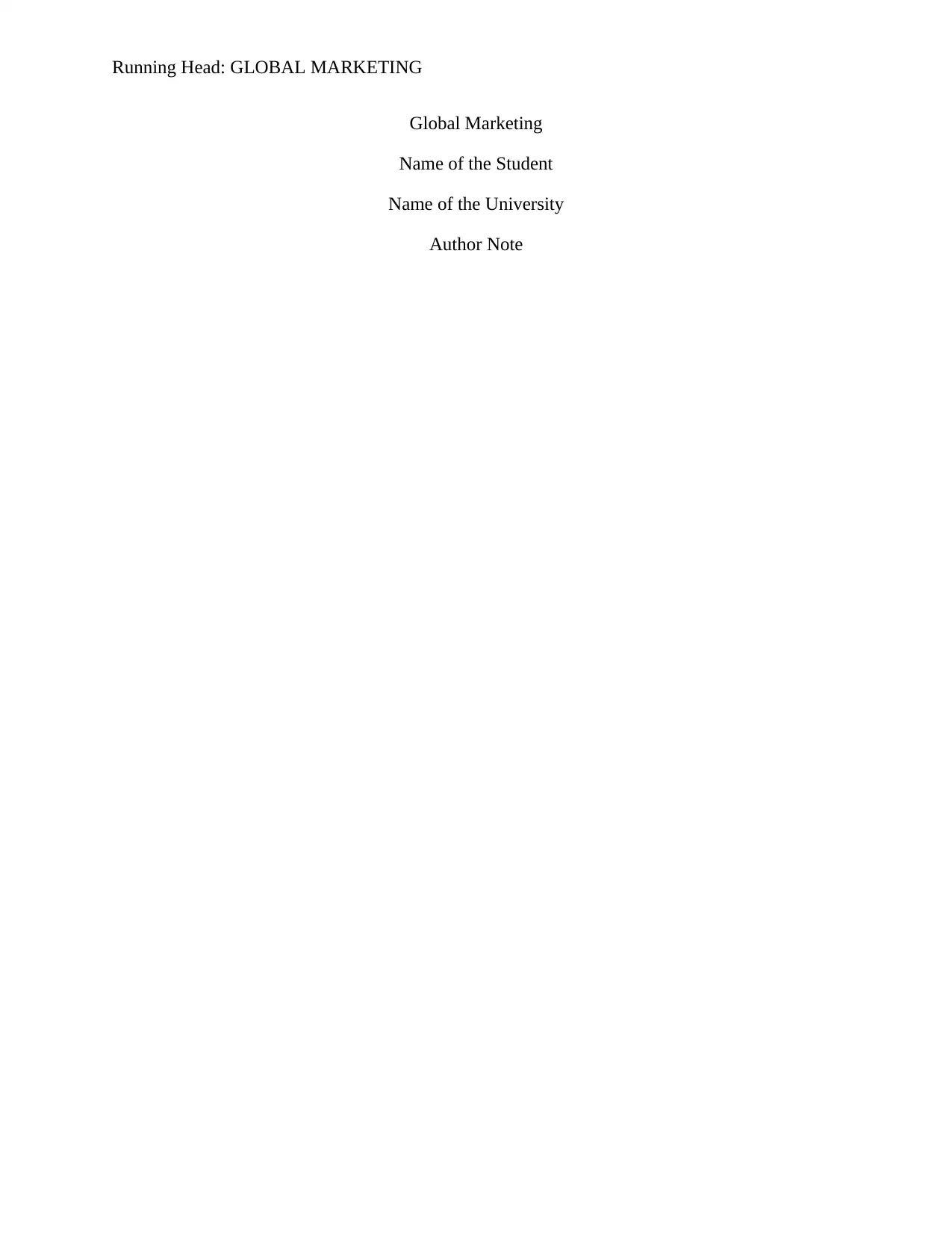
Running Head: GLOBAL MARKETING
Global Marketing
Name of the Student
Name of the University
Author Note
Global Marketing
Name of the Student
Name of the University
Author Note
Secure Best Marks with AI Grader
Need help grading? Try our AI Grader for instant feedback on your assignments.
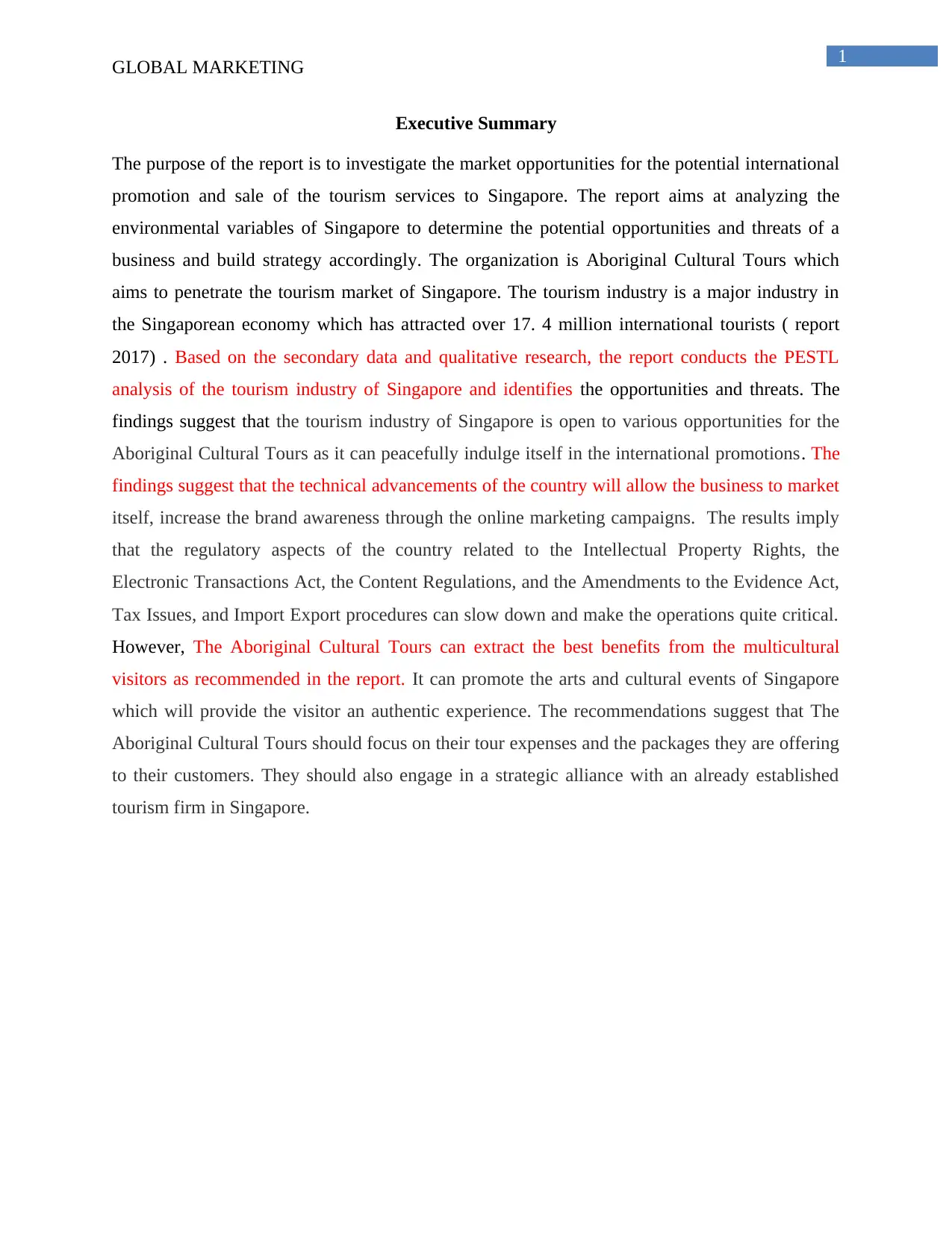
1
GLOBAL MARKETING
Executive Summary
The purpose of the report is to investigate the market opportunities for the potential international
promotion and sale of the tourism services to Singapore. The report aims at analyzing the
environmental variables of Singapore to determine the potential opportunities and threats of a
business and build strategy accordingly. The organization is Aboriginal Cultural Tours which
aims to penetrate the tourism market of Singapore. The tourism industry is a major industry in
the Singaporean economy which has attracted over 17. 4 million international tourists ( report
2017) . Based on the secondary data and qualitative research, the report conducts the PESTL
analysis of the tourism industry of Singapore and identifies the opportunities and threats. The
findings suggest that the tourism industry of Singapore is open to various opportunities for the
Aboriginal Cultural Tours as it can peacefully indulge itself in the international promotions. The
findings suggest that the technical advancements of the country will allow the business to market
itself, increase the brand awareness through the online marketing campaigns. The results imply
that the regulatory aspects of the country related to the Intellectual Property Rights, the
Electronic Transactions Act, the Content Regulations, and the Amendments to the Evidence Act,
Tax Issues, and Import Export procedures can slow down and make the operations quite critical.
However, The Aboriginal Cultural Tours can extract the best benefits from the multicultural
visitors as recommended in the report. It can promote the arts and cultural events of Singapore
which will provide the visitor an authentic experience. The recommendations suggest that The
Aboriginal Cultural Tours should focus on their tour expenses and the packages they are offering
to their customers. They should also engage in a strategic alliance with an already established
tourism firm in Singapore.
GLOBAL MARKETING
Executive Summary
The purpose of the report is to investigate the market opportunities for the potential international
promotion and sale of the tourism services to Singapore. The report aims at analyzing the
environmental variables of Singapore to determine the potential opportunities and threats of a
business and build strategy accordingly. The organization is Aboriginal Cultural Tours which
aims to penetrate the tourism market of Singapore. The tourism industry is a major industry in
the Singaporean economy which has attracted over 17. 4 million international tourists ( report
2017) . Based on the secondary data and qualitative research, the report conducts the PESTL
analysis of the tourism industry of Singapore and identifies the opportunities and threats. The
findings suggest that the tourism industry of Singapore is open to various opportunities for the
Aboriginal Cultural Tours as it can peacefully indulge itself in the international promotions. The
findings suggest that the technical advancements of the country will allow the business to market
itself, increase the brand awareness through the online marketing campaigns. The results imply
that the regulatory aspects of the country related to the Intellectual Property Rights, the
Electronic Transactions Act, the Content Regulations, and the Amendments to the Evidence Act,
Tax Issues, and Import Export procedures can slow down and make the operations quite critical.
However, The Aboriginal Cultural Tours can extract the best benefits from the multicultural
visitors as recommended in the report. It can promote the arts and cultural events of Singapore
which will provide the visitor an authentic experience. The recommendations suggest that The
Aboriginal Cultural Tours should focus on their tour expenses and the packages they are offering
to their customers. They should also engage in a strategic alliance with an already established
tourism firm in Singapore.
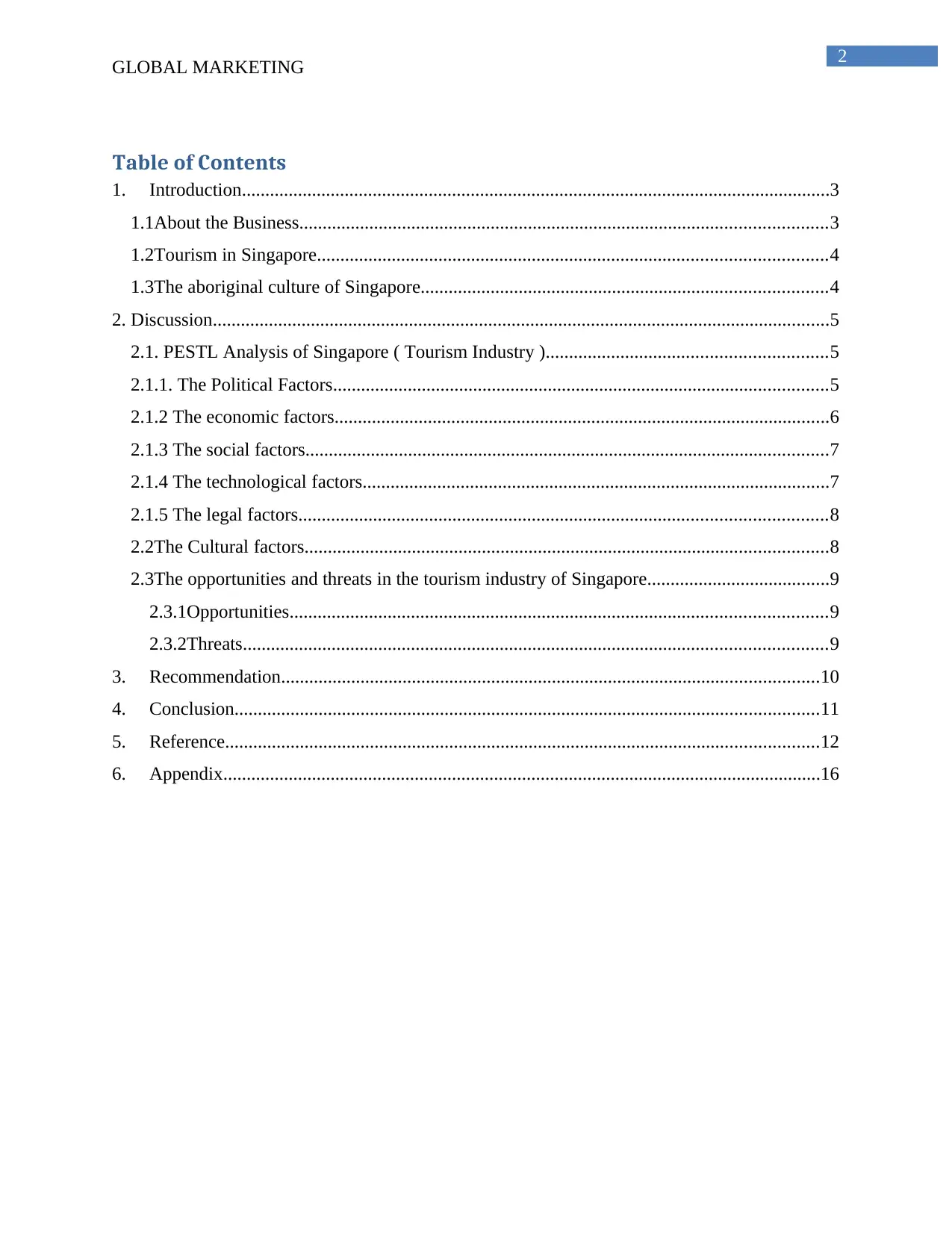
2
GLOBAL MARKETING
Table of Contents
1. Introduction..............................................................................................................................3
1.1About the Business.................................................................................................................3
1.2Tourism in Singapore.............................................................................................................4
1.3The aboriginal culture of Singapore.......................................................................................4
2. Discussion....................................................................................................................................5
2.1. PESTL Analysis of Singapore ( Tourism Industry )............................................................5
2.1.1. The Political Factors..........................................................................................................5
2.1.2 The economic factors..........................................................................................................6
2.1.3 The social factors................................................................................................................7
2.1.4 The technological factors....................................................................................................7
2.1.5 The legal factors.................................................................................................................8
2.2The Cultural factors................................................................................................................8
2.3The opportunities and threats in the tourism industry of Singapore.......................................9
2.3.1Opportunities...................................................................................................................9
2.3.2Threats.............................................................................................................................9
3. Recommendation...................................................................................................................10
4. Conclusion.............................................................................................................................11
5. Reference...............................................................................................................................12
6. Appendix................................................................................................................................16
GLOBAL MARKETING
Table of Contents
1. Introduction..............................................................................................................................3
1.1About the Business.................................................................................................................3
1.2Tourism in Singapore.............................................................................................................4
1.3The aboriginal culture of Singapore.......................................................................................4
2. Discussion....................................................................................................................................5
2.1. PESTL Analysis of Singapore ( Tourism Industry )............................................................5
2.1.1. The Political Factors..........................................................................................................5
2.1.2 The economic factors..........................................................................................................6
2.1.3 The social factors................................................................................................................7
2.1.4 The technological factors....................................................................................................7
2.1.5 The legal factors.................................................................................................................8
2.2The Cultural factors................................................................................................................8
2.3The opportunities and threats in the tourism industry of Singapore.......................................9
2.3.1Opportunities...................................................................................................................9
2.3.2Threats.............................................................................................................................9
3. Recommendation...................................................................................................................10
4. Conclusion.............................................................................................................................11
5. Reference...............................................................................................................................12
6. Appendix................................................................................................................................16
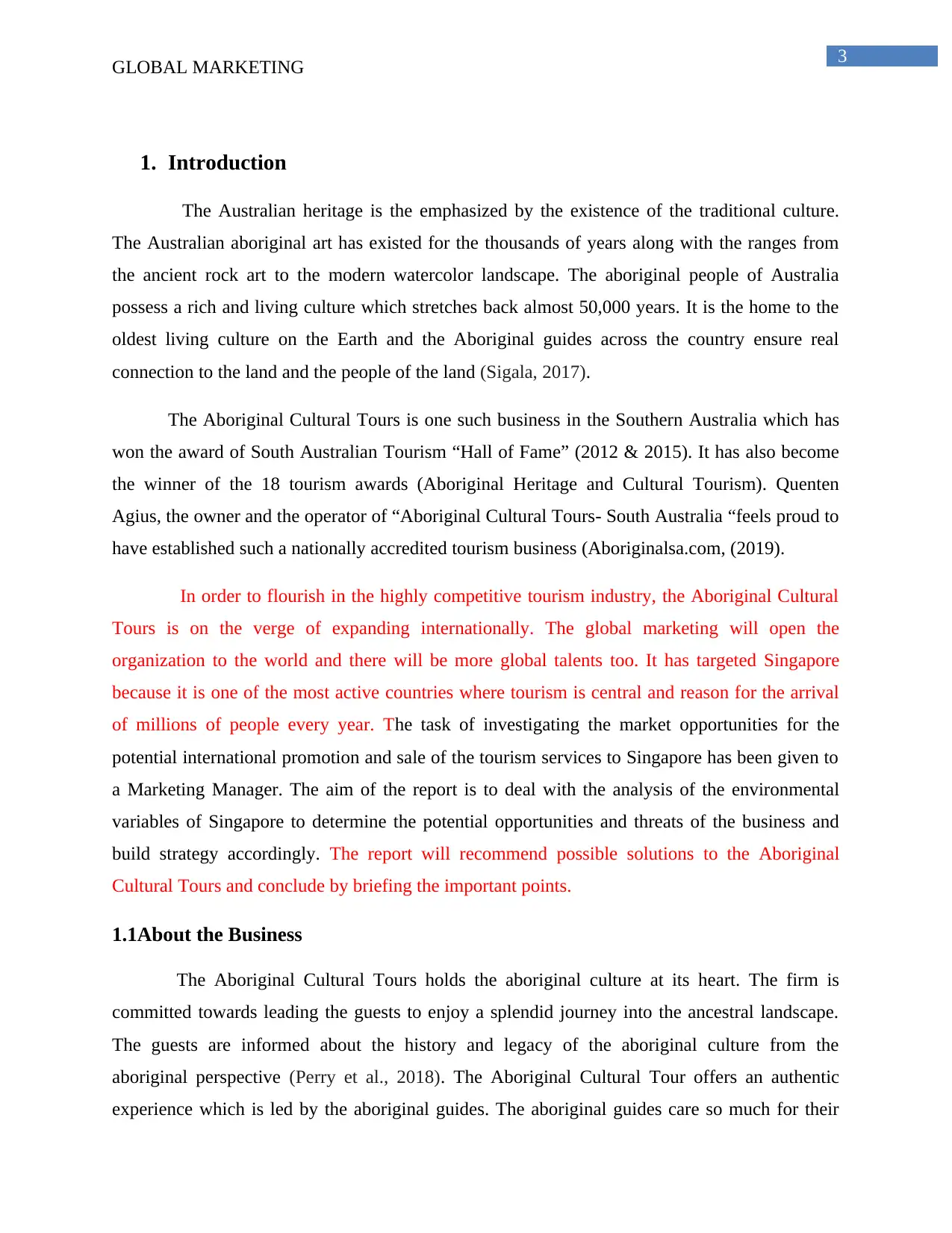
3
GLOBAL MARKETING
1. Introduction
The Australian heritage is the emphasized by the existence of the traditional culture.
The Australian aboriginal art has existed for the thousands of years along with the ranges from
the ancient rock art to the modern watercolor landscape. The aboriginal people of Australia
possess a rich and living culture which stretches back almost 50,000 years. It is the home to the
oldest living culture on the Earth and the Aboriginal guides across the country ensure real
connection to the land and the people of the land (Sigala, 2017).
The Aboriginal Cultural Tours is one such business in the Southern Australia which has
won the award of South Australian Tourism “Hall of Fame” (2012 & 2015). It has also become
the winner of the 18 tourism awards (Aboriginal Heritage and Cultural Tourism). Quenten
Agius, the owner and the operator of “Aboriginal Cultural Tours- South Australia “feels proud to
have established such a nationally accredited tourism business (Aboriginalsa.com, (2019).
In order to flourish in the highly competitive tourism industry, the Aboriginal Cultural
Tours is on the verge of expanding internationally. The global marketing will open the
organization to the world and there will be more global talents too. It has targeted Singapore
because it is one of the most active countries where tourism is central and reason for the arrival
of millions of people every year. The task of investigating the market opportunities for the
potential international promotion and sale of the tourism services to Singapore has been given to
a Marketing Manager. The aim of the report is to deal with the analysis of the environmental
variables of Singapore to determine the potential opportunities and threats of the business and
build strategy accordingly. The report will recommend possible solutions to the Aboriginal
Cultural Tours and conclude by briefing the important points.
1.1About the Business
The Aboriginal Cultural Tours holds the aboriginal culture at its heart. The firm is
committed towards leading the guests to enjoy a splendid journey into the ancestral landscape.
The guests are informed about the history and legacy of the aboriginal culture from the
aboriginal perspective (Perry et al., 2018). The Aboriginal Cultural Tour offers an authentic
experience which is led by the aboriginal guides. The aboriginal guides care so much for their
GLOBAL MARKETING
1. Introduction
The Australian heritage is the emphasized by the existence of the traditional culture.
The Australian aboriginal art has existed for the thousands of years along with the ranges from
the ancient rock art to the modern watercolor landscape. The aboriginal people of Australia
possess a rich and living culture which stretches back almost 50,000 years. It is the home to the
oldest living culture on the Earth and the Aboriginal guides across the country ensure real
connection to the land and the people of the land (Sigala, 2017).
The Aboriginal Cultural Tours is one such business in the Southern Australia which has
won the award of South Australian Tourism “Hall of Fame” (2012 & 2015). It has also become
the winner of the 18 tourism awards (Aboriginal Heritage and Cultural Tourism). Quenten
Agius, the owner and the operator of “Aboriginal Cultural Tours- South Australia “feels proud to
have established such a nationally accredited tourism business (Aboriginalsa.com, (2019).
In order to flourish in the highly competitive tourism industry, the Aboriginal Cultural
Tours is on the verge of expanding internationally. The global marketing will open the
organization to the world and there will be more global talents too. It has targeted Singapore
because it is one of the most active countries where tourism is central and reason for the arrival
of millions of people every year. The task of investigating the market opportunities for the
potential international promotion and sale of the tourism services to Singapore has been given to
a Marketing Manager. The aim of the report is to deal with the analysis of the environmental
variables of Singapore to determine the potential opportunities and threats of the business and
build strategy accordingly. The report will recommend possible solutions to the Aboriginal
Cultural Tours and conclude by briefing the important points.
1.1About the Business
The Aboriginal Cultural Tours holds the aboriginal culture at its heart. The firm is
committed towards leading the guests to enjoy a splendid journey into the ancestral landscape.
The guests are informed about the history and legacy of the aboriginal culture from the
aboriginal perspective (Perry et al., 2018). The Aboriginal Cultural Tour offers an authentic
experience which is led by the aboriginal guides. The aboriginal guides care so much for their
Secure Best Marks with AI Grader
Need help grading? Try our AI Grader for instant feedback on your assignments.
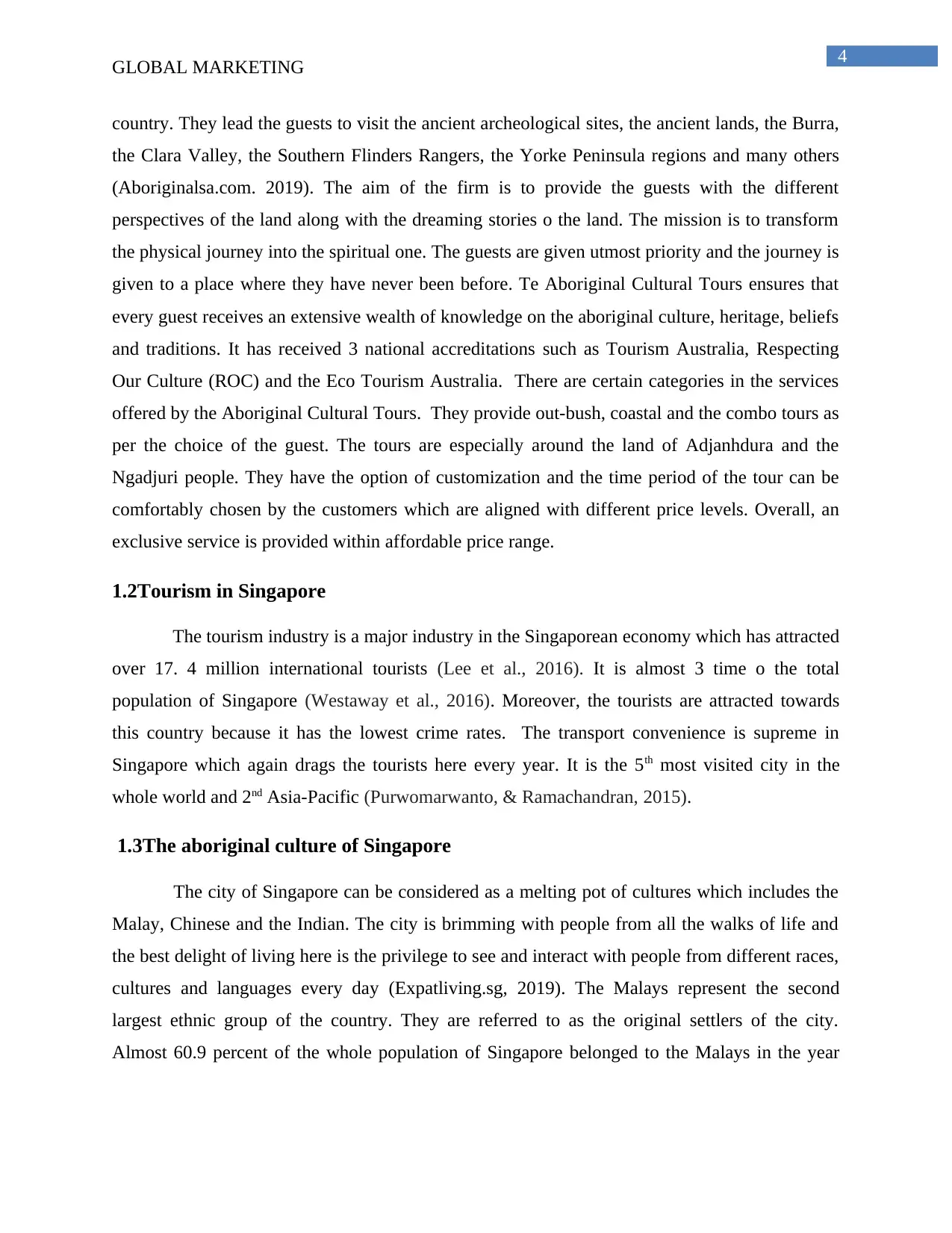
4
GLOBAL MARKETING
country. They lead the guests to visit the ancient archeological sites, the ancient lands, the Burra,
the Clara Valley, the Southern Flinders Rangers, the Yorke Peninsula regions and many others
(Aboriginalsa.com. 2019). The aim of the firm is to provide the guests with the different
perspectives of the land along with the dreaming stories o the land. The mission is to transform
the physical journey into the spiritual one. The guests are given utmost priority and the journey is
given to a place where they have never been before. Te Aboriginal Cultural Tours ensures that
every guest receives an extensive wealth of knowledge on the aboriginal culture, heritage, beliefs
and traditions. It has received 3 national accreditations such as Tourism Australia, Respecting
Our Culture (ROC) and the Eco Tourism Australia. There are certain categories in the services
offered by the Aboriginal Cultural Tours. They provide out-bush, coastal and the combo tours as
per the choice of the guest. The tours are especially around the land of Adjanhdura and the
Ngadjuri people. They have the option of customization and the time period of the tour can be
comfortably chosen by the customers which are aligned with different price levels. Overall, an
exclusive service is provided within affordable price range.
1.2Tourism in Singapore
The tourism industry is a major industry in the Singaporean economy which has attracted
over 17. 4 million international tourists (Lee et al., 2016). It is almost 3 time o the total
population of Singapore (Westaway et al., 2016). Moreover, the tourists are attracted towards
this country because it has the lowest crime rates. The transport convenience is supreme in
Singapore which again drags the tourists here every year. It is the 5th most visited city in the
whole world and 2nd Asia-Pacific (Purwomarwanto, & Ramachandran, 2015).
1.3The aboriginal culture of Singapore
The city of Singapore can be considered as a melting pot of cultures which includes the
Malay, Chinese and the Indian. The city is brimming with people from all the walks of life and
the best delight of living here is the privilege to see and interact with people from different races,
cultures and languages every day (Expatliving.sg, 2019). The Malays represent the second
largest ethnic group of the country. They are referred to as the original settlers of the city.
Almost 60.9 percent of the whole population of Singapore belonged to the Malays in the year
GLOBAL MARKETING
country. They lead the guests to visit the ancient archeological sites, the ancient lands, the Burra,
the Clara Valley, the Southern Flinders Rangers, the Yorke Peninsula regions and many others
(Aboriginalsa.com. 2019). The aim of the firm is to provide the guests with the different
perspectives of the land along with the dreaming stories o the land. The mission is to transform
the physical journey into the spiritual one. The guests are given utmost priority and the journey is
given to a place where they have never been before. Te Aboriginal Cultural Tours ensures that
every guest receives an extensive wealth of knowledge on the aboriginal culture, heritage, beliefs
and traditions. It has received 3 national accreditations such as Tourism Australia, Respecting
Our Culture (ROC) and the Eco Tourism Australia. There are certain categories in the services
offered by the Aboriginal Cultural Tours. They provide out-bush, coastal and the combo tours as
per the choice of the guest. The tours are especially around the land of Adjanhdura and the
Ngadjuri people. They have the option of customization and the time period of the tour can be
comfortably chosen by the customers which are aligned with different price levels. Overall, an
exclusive service is provided within affordable price range.
1.2Tourism in Singapore
The tourism industry is a major industry in the Singaporean economy which has attracted
over 17. 4 million international tourists (Lee et al., 2016). It is almost 3 time o the total
population of Singapore (Westaway et al., 2016). Moreover, the tourists are attracted towards
this country because it has the lowest crime rates. The transport convenience is supreme in
Singapore which again drags the tourists here every year. It is the 5th most visited city in the
whole world and 2nd Asia-Pacific (Purwomarwanto, & Ramachandran, 2015).
1.3The aboriginal culture of Singapore
The city of Singapore can be considered as a melting pot of cultures which includes the
Malay, Chinese and the Indian. The city is brimming with people from all the walks of life and
the best delight of living here is the privilege to see and interact with people from different races,
cultures and languages every day (Expatliving.sg, 2019). The Malays represent the second
largest ethnic group of the country. They are referred to as the original settlers of the city.
Almost 60.9 percent of the whole population of Singapore belonged to the Malays in the year
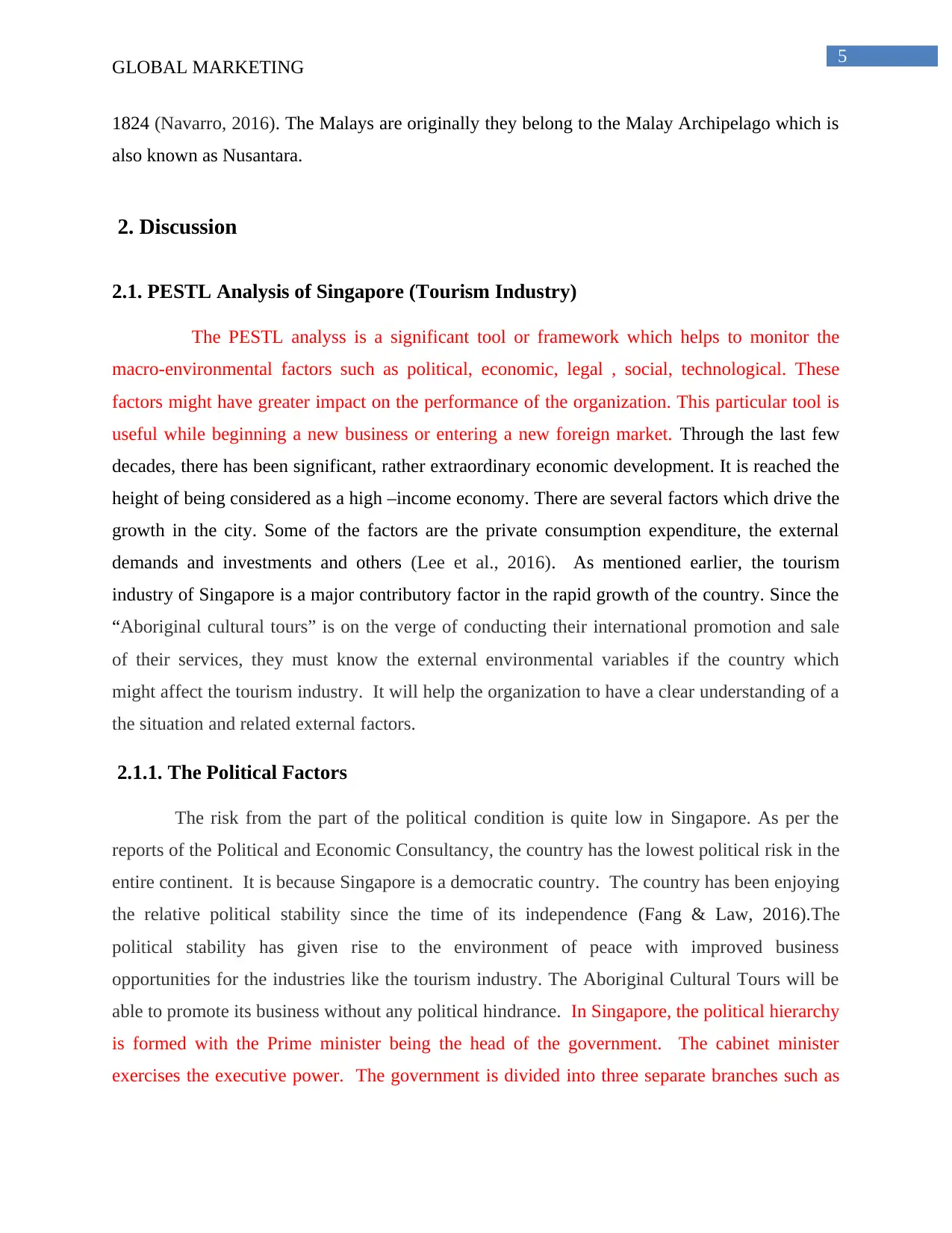
5
GLOBAL MARKETING
1824 (Navarro, 2016). The Malays are originally they belong to the Malay Archipelago which is
also known as Nusantara.
2. Discussion
2.1. PESTL Analysis of Singapore (Tourism Industry)
The PESTL analyss is a significant tool or framework which helps to monitor the
macro-environmental factors such as political, economic, legal , social, technological. These
factors might have greater impact on the performance of the organization. This particular tool is
useful while beginning a new business or entering a new foreign market. Through the last few
decades, there has been significant, rather extraordinary economic development. It is reached the
height of being considered as a high –income economy. There are several factors which drive the
growth in the city. Some of the factors are the private consumption expenditure, the external
demands and investments and others (Lee et al., 2016). As mentioned earlier, the tourism
industry of Singapore is a major contributory factor in the rapid growth of the country. Since the
“Aboriginal cultural tours” is on the verge of conducting their international promotion and sale
of their services, they must know the external environmental variables if the country which
might affect the tourism industry. It will help the organization to have a clear understanding of a
the situation and related external factors.
2.1.1. The Political Factors
The risk from the part of the political condition is quite low in Singapore. As per the
reports of the Political and Economic Consultancy, the country has the lowest political risk in the
entire continent. It is because Singapore is a democratic country. The country has been enjoying
the relative political stability since the time of its independence (Fang & Law, 2016).The
political stability has given rise to the environment of peace with improved business
opportunities for the industries like the tourism industry. The Aboriginal Cultural Tours will be
able to promote its business without any political hindrance. In Singapore, the political hierarchy
is formed with the Prime minister being the head of the government. The cabinet minister
exercises the executive power. The government is divided into three separate branches such as
GLOBAL MARKETING
1824 (Navarro, 2016). The Malays are originally they belong to the Malay Archipelago which is
also known as Nusantara.
2. Discussion
2.1. PESTL Analysis of Singapore (Tourism Industry)
The PESTL analyss is a significant tool or framework which helps to monitor the
macro-environmental factors such as political, economic, legal , social, technological. These
factors might have greater impact on the performance of the organization. This particular tool is
useful while beginning a new business or entering a new foreign market. Through the last few
decades, there has been significant, rather extraordinary economic development. It is reached the
height of being considered as a high –income economy. There are several factors which drive the
growth in the city. Some of the factors are the private consumption expenditure, the external
demands and investments and others (Lee et al., 2016). As mentioned earlier, the tourism
industry of Singapore is a major contributory factor in the rapid growth of the country. Since the
“Aboriginal cultural tours” is on the verge of conducting their international promotion and sale
of their services, they must know the external environmental variables if the country which
might affect the tourism industry. It will help the organization to have a clear understanding of a
the situation and related external factors.
2.1.1. The Political Factors
The risk from the part of the political condition is quite low in Singapore. As per the
reports of the Political and Economic Consultancy, the country has the lowest political risk in the
entire continent. It is because Singapore is a democratic country. The country has been enjoying
the relative political stability since the time of its independence (Fang & Law, 2016).The
political stability has given rise to the environment of peace with improved business
opportunities for the industries like the tourism industry. The Aboriginal Cultural Tours will be
able to promote its business without any political hindrance. In Singapore, the political hierarchy
is formed with the Prime minister being the head of the government. The cabinet minister
exercises the executive power. The government is divided into three separate branches such as
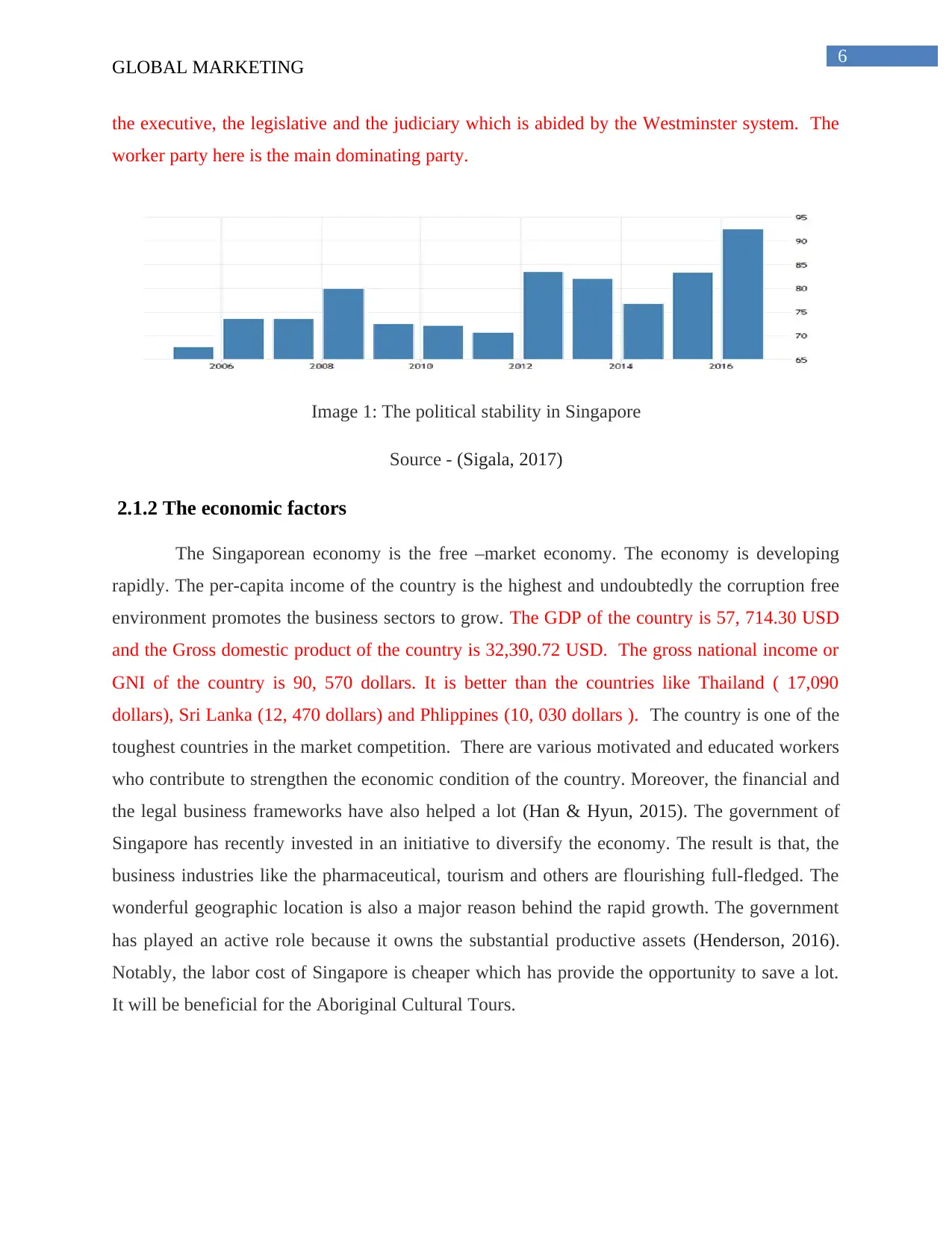
6
GLOBAL MARKETING
the executive, the legislative and the judiciary which is abided by the Westminster system. The
worker party here is the main dominating party.
Image 1: The political stability in Singapore
Source - (Sigala, 2017)
2.1.2 The economic factors
The Singaporean economy is the free –market economy. The economy is developing
rapidly. The per-capita income of the country is the highest and undoubtedly the corruption free
environment promotes the business sectors to grow. The GDP of the country is 57, 714.30 USD
and the Gross domestic product of the country is 32,390.72 USD. The gross national income or
GNI of the country is 90, 570 dollars. It is better than the countries like Thailand ( 17,090
dollars), Sri Lanka (12, 470 dollars) and Phlippines (10, 030 dollars ). The country is one of the
toughest countries in the market competition. There are various motivated and educated workers
who contribute to strengthen the economic condition of the country. Moreover, the financial and
the legal business frameworks have also helped a lot (Han & Hyun, 2015). The government of
Singapore has recently invested in an initiative to diversify the economy. The result is that, the
business industries like the pharmaceutical, tourism and others are flourishing full-fledged. The
wonderful geographic location is also a major reason behind the rapid growth. The government
has played an active role because it owns the substantial productive assets (Henderson, 2016).
Notably, the labor cost of Singapore is cheaper which has provide the opportunity to save a lot.
It will be beneficial for the Aboriginal Cultural Tours.
GLOBAL MARKETING
the executive, the legislative and the judiciary which is abided by the Westminster system. The
worker party here is the main dominating party.
Image 1: The political stability in Singapore
Source - (Sigala, 2017)
2.1.2 The economic factors
The Singaporean economy is the free –market economy. The economy is developing
rapidly. The per-capita income of the country is the highest and undoubtedly the corruption free
environment promotes the business sectors to grow. The GDP of the country is 57, 714.30 USD
and the Gross domestic product of the country is 32,390.72 USD. The gross national income or
GNI of the country is 90, 570 dollars. It is better than the countries like Thailand ( 17,090
dollars), Sri Lanka (12, 470 dollars) and Phlippines (10, 030 dollars ). The country is one of the
toughest countries in the market competition. There are various motivated and educated workers
who contribute to strengthen the economic condition of the country. Moreover, the financial and
the legal business frameworks have also helped a lot (Han & Hyun, 2015). The government of
Singapore has recently invested in an initiative to diversify the economy. The result is that, the
business industries like the pharmaceutical, tourism and others are flourishing full-fledged. The
wonderful geographic location is also a major reason behind the rapid growth. The government
has played an active role because it owns the substantial productive assets (Henderson, 2016).
Notably, the labor cost of Singapore is cheaper which has provide the opportunity to save a lot.
It will be beneficial for the Aboriginal Cultural Tours.
Paraphrase This Document
Need a fresh take? Get an instant paraphrase of this document with our AI Paraphraser
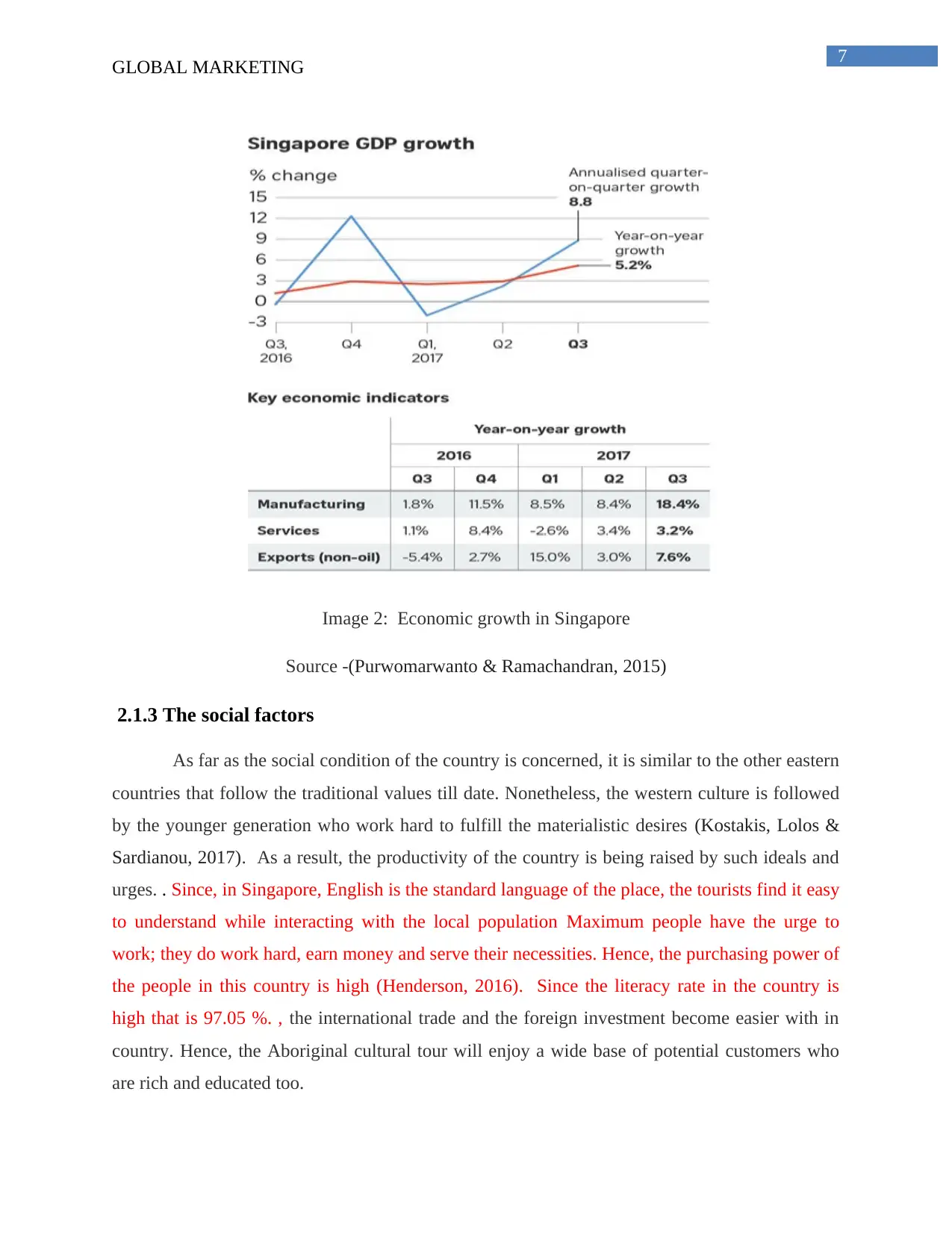
7
GLOBAL MARKETING
Image 2: Economic growth in Singapore
Source -(Purwomarwanto & Ramachandran, 2015)
2.1.3 The social factors
As far as the social condition of the country is concerned, it is similar to the other eastern
countries that follow the traditional values till date. Nonetheless, the western culture is followed
by the younger generation who work hard to fulfill the materialistic desires (Kostakis, Lolos &
Sardianou, 2017). As a result, the productivity of the country is being raised by such ideals and
urges. . Since, in Singapore, English is the standard language of the place, the tourists find it easy
to understand while interacting with the local population Maximum people have the urge to
work; they do work hard, earn money and serve their necessities. Hence, the purchasing power of
the people in this country is high (Henderson, 2016). Since the literacy rate in the country is
high that is 97.05 %. , the international trade and the foreign investment become easier with in
country. Hence, the Aboriginal cultural tour will enjoy a wide base of potential customers who
are rich and educated too.
GLOBAL MARKETING
Image 2: Economic growth in Singapore
Source -(Purwomarwanto & Ramachandran, 2015)
2.1.3 The social factors
As far as the social condition of the country is concerned, it is similar to the other eastern
countries that follow the traditional values till date. Nonetheless, the western culture is followed
by the younger generation who work hard to fulfill the materialistic desires (Kostakis, Lolos &
Sardianou, 2017). As a result, the productivity of the country is being raised by such ideals and
urges. . Since, in Singapore, English is the standard language of the place, the tourists find it easy
to understand while interacting with the local population Maximum people have the urge to
work; they do work hard, earn money and serve their necessities. Hence, the purchasing power of
the people in this country is high (Henderson, 2016). Since the literacy rate in the country is
high that is 97.05 %. , the international trade and the foreign investment become easier with in
country. Hence, the Aboriginal cultural tour will enjoy a wide base of potential customers who
are rich and educated too.
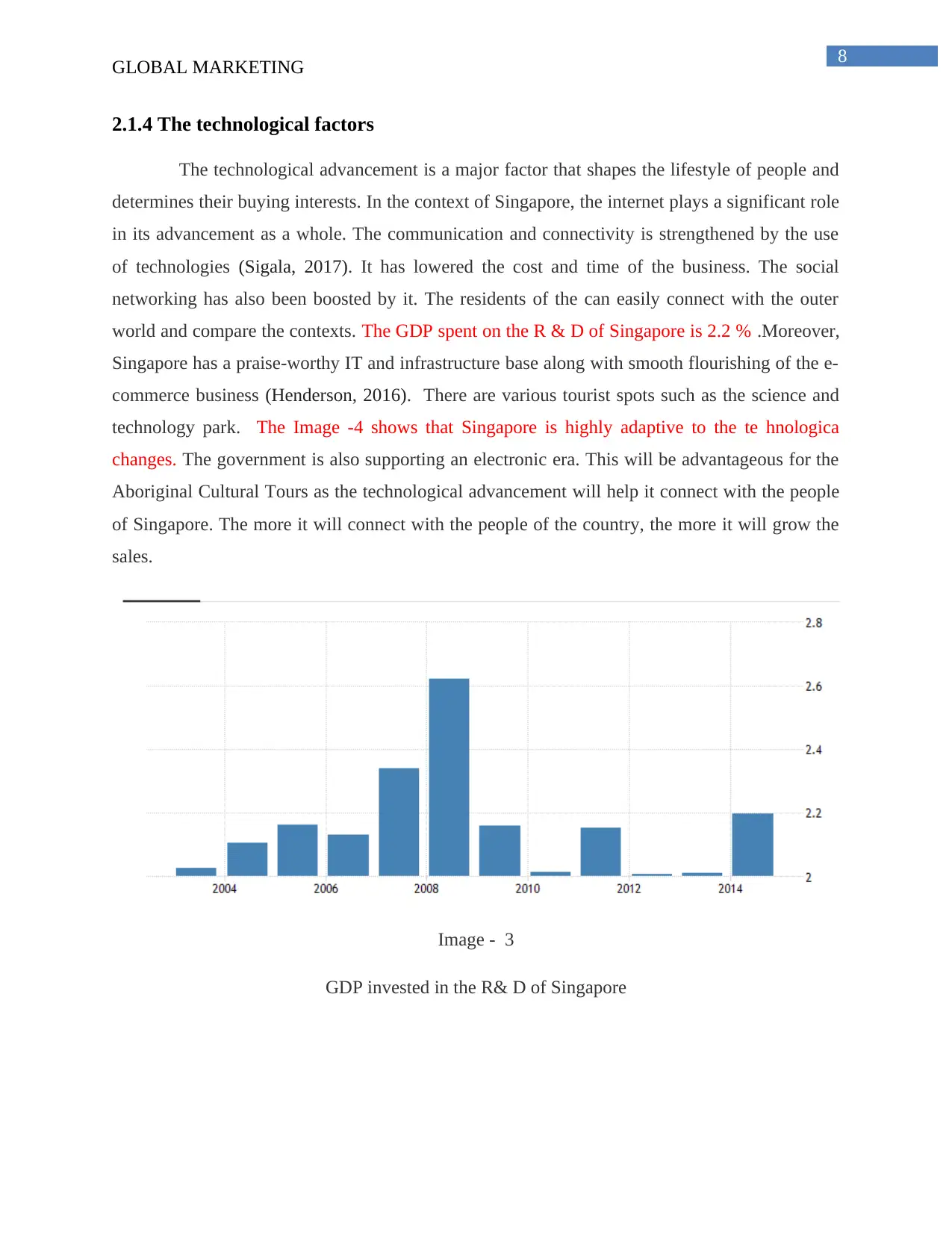
8
GLOBAL MARKETING
2.1.4 The technological factors
The technological advancement is a major factor that shapes the lifestyle of people and
determines their buying interests. In the context of Singapore, the internet plays a significant role
in its advancement as a whole. The communication and connectivity is strengthened by the use
of technologies (Sigala, 2017). It has lowered the cost and time of the business. The social
networking has also been boosted by it. The residents of the can easily connect with the outer
world and compare the contexts. The GDP spent on the R & D of Singapore is 2.2 % .Moreover,
Singapore has a praise-worthy IT and infrastructure base along with smooth flourishing of the e-
commerce business (Henderson, 2016). There are various tourist spots such as the science and
technology park. The Image -4 shows that Singapore is highly adaptive to the te hnologica
changes. The government is also supporting an electronic era. This will be advantageous for the
Aboriginal Cultural Tours as the technological advancement will help it connect with the people
of Singapore. The more it will connect with the people of the country, the more it will grow the
sales.
Image - 3
GDP invested in the R& D of Singapore
GLOBAL MARKETING
2.1.4 The technological factors
The technological advancement is a major factor that shapes the lifestyle of people and
determines their buying interests. In the context of Singapore, the internet plays a significant role
in its advancement as a whole. The communication and connectivity is strengthened by the use
of technologies (Sigala, 2017). It has lowered the cost and time of the business. The social
networking has also been boosted by it. The residents of the can easily connect with the outer
world and compare the contexts. The GDP spent on the R & D of Singapore is 2.2 % .Moreover,
Singapore has a praise-worthy IT and infrastructure base along with smooth flourishing of the e-
commerce business (Henderson, 2016). There are various tourist spots such as the science and
technology park. The Image -4 shows that Singapore is highly adaptive to the te hnologica
changes. The government is also supporting an electronic era. This will be advantageous for the
Aboriginal Cultural Tours as the technological advancement will help it connect with the people
of Singapore. The more it will connect with the people of the country, the more it will grow the
sales.
Image - 3
GDP invested in the R& D of Singapore
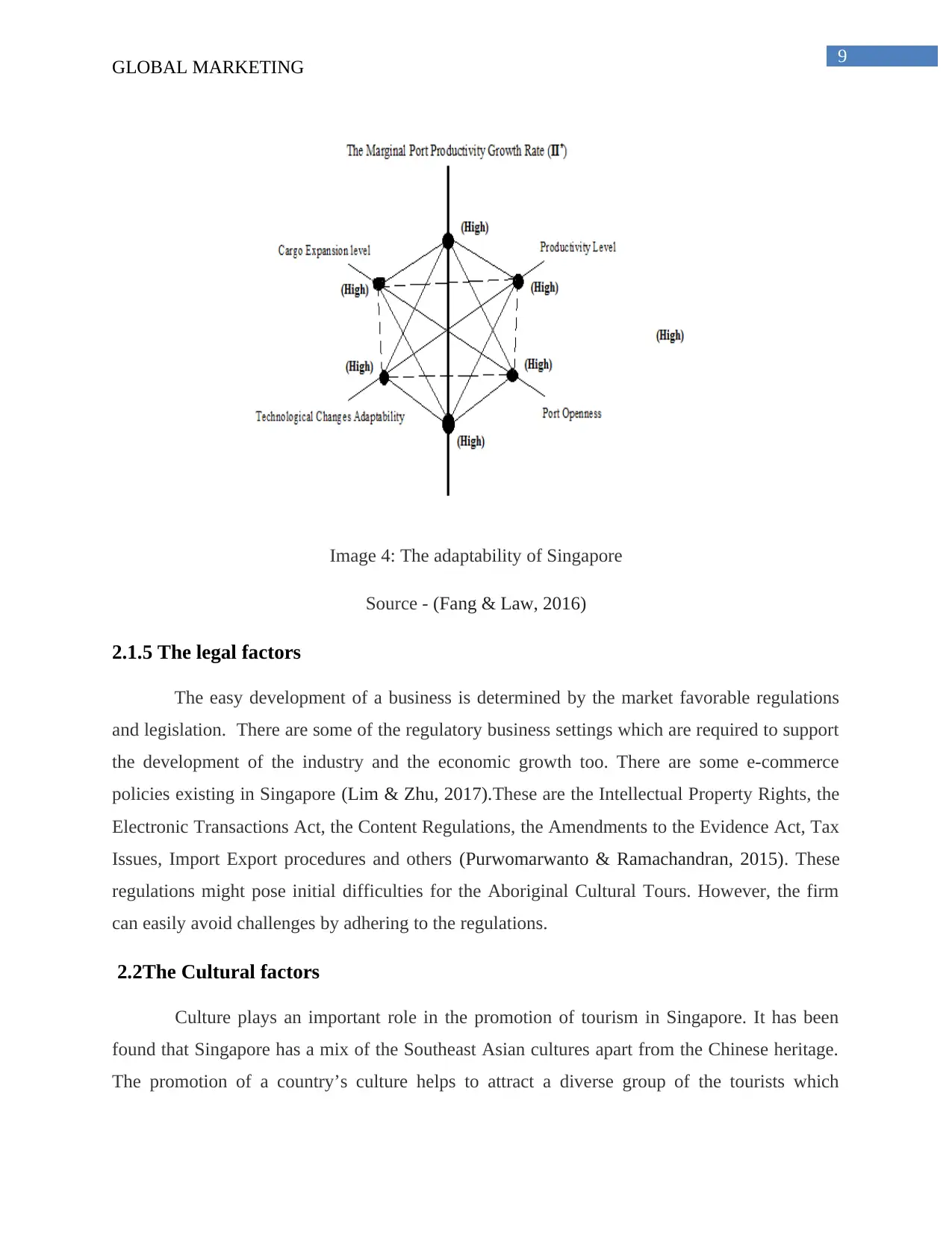
9
GLOBAL MARKETING
Image 4: The adaptability of Singapore
Source - (Fang & Law, 2016)
2.1.5 The legal factors
The easy development of a business is determined by the market favorable regulations
and legislation. There are some of the regulatory business settings which are required to support
the development of the industry and the economic growth too. There are some e-commerce
policies existing in Singapore (Lim & Zhu, 2017).These are the Intellectual Property Rights, the
Electronic Transactions Act, the Content Regulations, the Amendments to the Evidence Act, Tax
Issues, Import Export procedures and others (Purwomarwanto & Ramachandran, 2015). These
regulations might pose initial difficulties for the Aboriginal Cultural Tours. However, the firm
can easily avoid challenges by adhering to the regulations.
2.2The Cultural factors
Culture plays an important role in the promotion of tourism in Singapore. It has been
found that Singapore has a mix of the Southeast Asian cultures apart from the Chinese heritage.
The promotion of a country’s culture helps to attract a diverse group of the tourists which
GLOBAL MARKETING
Image 4: The adaptability of Singapore
Source - (Fang & Law, 2016)
2.1.5 The legal factors
The easy development of a business is determined by the market favorable regulations
and legislation. There are some of the regulatory business settings which are required to support
the development of the industry and the economic growth too. There are some e-commerce
policies existing in Singapore (Lim & Zhu, 2017).These are the Intellectual Property Rights, the
Electronic Transactions Act, the Content Regulations, the Amendments to the Evidence Act, Tax
Issues, Import Export procedures and others (Purwomarwanto & Ramachandran, 2015). These
regulations might pose initial difficulties for the Aboriginal Cultural Tours. However, the firm
can easily avoid challenges by adhering to the regulations.
2.2The Cultural factors
Culture plays an important role in the promotion of tourism in Singapore. It has been
found that Singapore has a mix of the Southeast Asian cultures apart from the Chinese heritage.
The promotion of a country’s culture helps to attract a diverse group of the tourists which
Secure Best Marks with AI Grader
Need help grading? Try our AI Grader for instant feedback on your assignments.
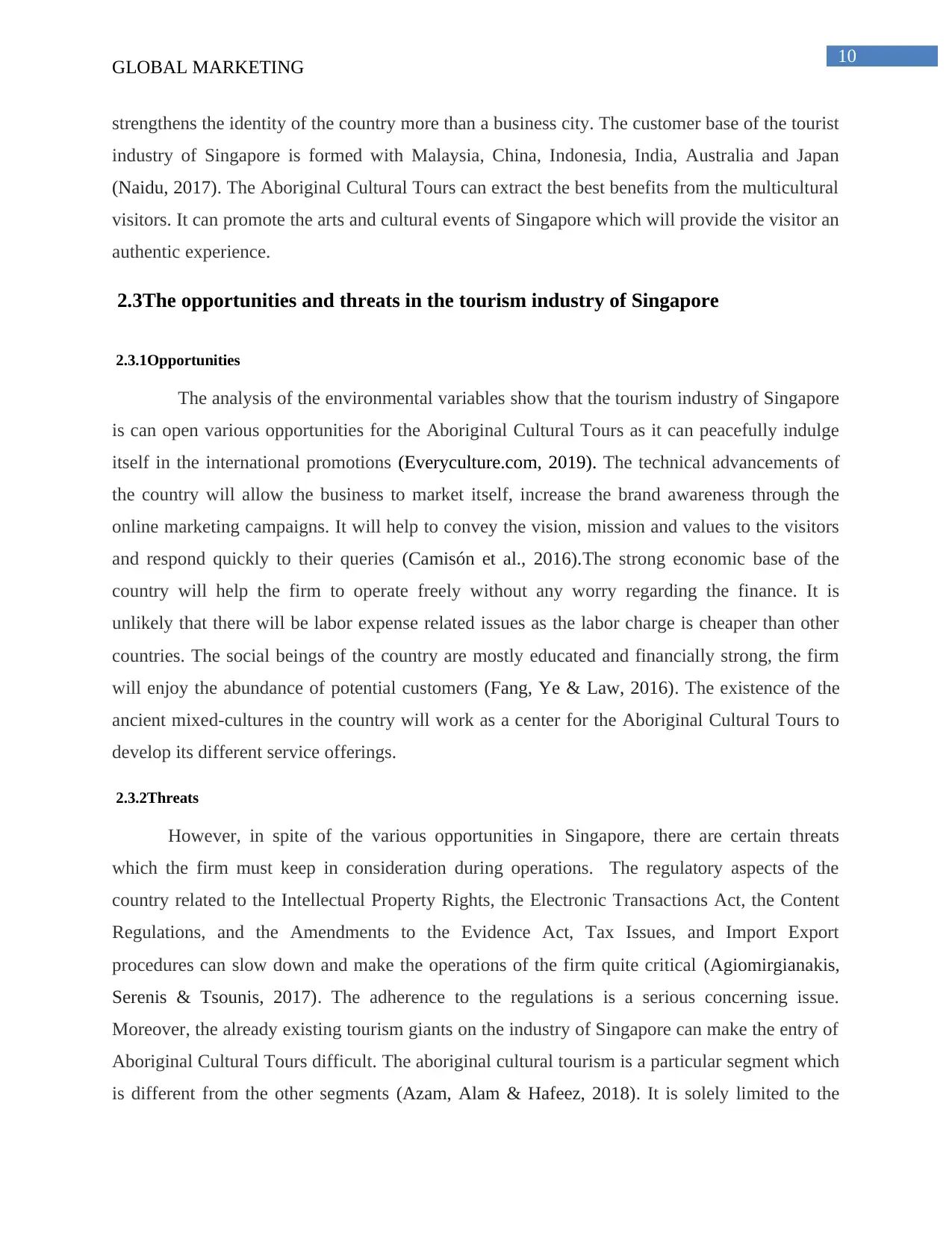
10
GLOBAL MARKETING
strengthens the identity of the country more than a business city. The customer base of the tourist
industry of Singapore is formed with Malaysia, China, Indonesia, India, Australia and Japan
(Naidu, 2017). The Aboriginal Cultural Tours can extract the best benefits from the multicultural
visitors. It can promote the arts and cultural events of Singapore which will provide the visitor an
authentic experience.
2.3The opportunities and threats in the tourism industry of Singapore
2.3.1Opportunities
The analysis of the environmental variables show that the tourism industry of Singapore
is can open various opportunities for the Aboriginal Cultural Tours as it can peacefully indulge
itself in the international promotions (Everyculture.com, 2019). The technical advancements of
the country will allow the business to market itself, increase the brand awareness through the
online marketing campaigns. It will help to convey the vision, mission and values to the visitors
and respond quickly to their queries (Camisón et al., 2016).The strong economic base of the
country will help the firm to operate freely without any worry regarding the finance. It is
unlikely that there will be labor expense related issues as the labor charge is cheaper than other
countries. The social beings of the country are mostly educated and financially strong, the firm
will enjoy the abundance of potential customers (Fang, Ye & Law, 2016). The existence of the
ancient mixed-cultures in the country will work as a center for the Aboriginal Cultural Tours to
develop its different service offerings.
2.3.2Threats
However, in spite of the various opportunities in Singapore, there are certain threats
which the firm must keep in consideration during operations. The regulatory aspects of the
country related to the Intellectual Property Rights, the Electronic Transactions Act, the Content
Regulations, and the Amendments to the Evidence Act, Tax Issues, and Import Export
procedures can slow down and make the operations of the firm quite critical (Agiomirgianakis,
Serenis & Tsounis, 2017). The adherence to the regulations is a serious concerning issue.
Moreover, the already existing tourism giants on the industry of Singapore can make the entry of
Aboriginal Cultural Tours difficult. The aboriginal cultural tourism is a particular segment which
is different from the other segments (Azam, Alam & Hafeez, 2018). It is solely limited to the
GLOBAL MARKETING
strengthens the identity of the country more than a business city. The customer base of the tourist
industry of Singapore is formed with Malaysia, China, Indonesia, India, Australia and Japan
(Naidu, 2017). The Aboriginal Cultural Tours can extract the best benefits from the multicultural
visitors. It can promote the arts and cultural events of Singapore which will provide the visitor an
authentic experience.
2.3The opportunities and threats in the tourism industry of Singapore
2.3.1Opportunities
The analysis of the environmental variables show that the tourism industry of Singapore
is can open various opportunities for the Aboriginal Cultural Tours as it can peacefully indulge
itself in the international promotions (Everyculture.com, 2019). The technical advancements of
the country will allow the business to market itself, increase the brand awareness through the
online marketing campaigns. It will help to convey the vision, mission and values to the visitors
and respond quickly to their queries (Camisón et al., 2016).The strong economic base of the
country will help the firm to operate freely without any worry regarding the finance. It is
unlikely that there will be labor expense related issues as the labor charge is cheaper than other
countries. The social beings of the country are mostly educated and financially strong, the firm
will enjoy the abundance of potential customers (Fang, Ye & Law, 2016). The existence of the
ancient mixed-cultures in the country will work as a center for the Aboriginal Cultural Tours to
develop its different service offerings.
2.3.2Threats
However, in spite of the various opportunities in Singapore, there are certain threats
which the firm must keep in consideration during operations. The regulatory aspects of the
country related to the Intellectual Property Rights, the Electronic Transactions Act, the Content
Regulations, and the Amendments to the Evidence Act, Tax Issues, and Import Export
procedures can slow down and make the operations of the firm quite critical (Agiomirgianakis,
Serenis & Tsounis, 2017). The adherence to the regulations is a serious concerning issue.
Moreover, the already existing tourism giants on the industry of Singapore can make the entry of
Aboriginal Cultural Tours difficult. The aboriginal cultural tourism is a particular segment which
is different from the other segments (Azam, Alam & Hafeez, 2018). It is solely limited to the
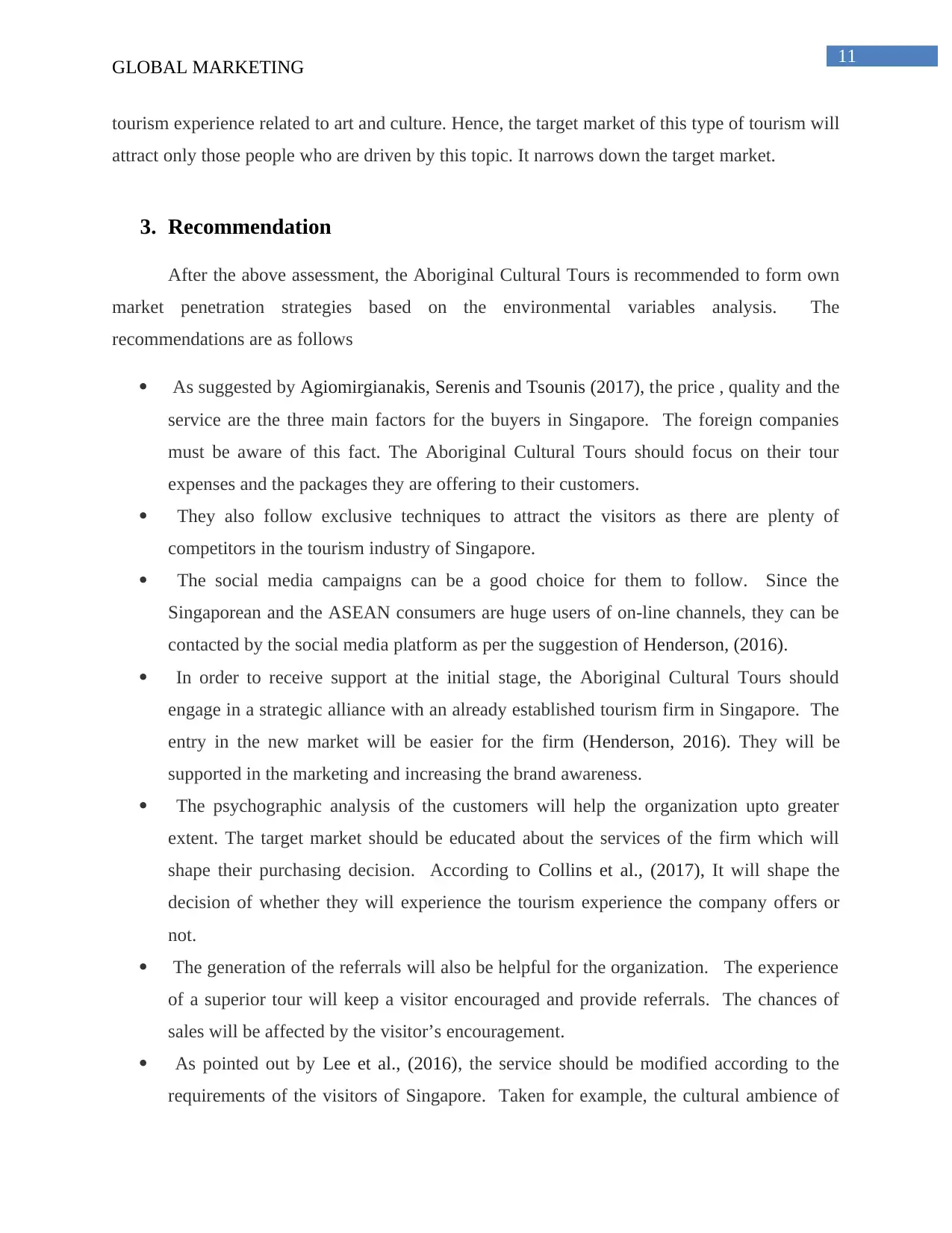
11
GLOBAL MARKETING
tourism experience related to art and culture. Hence, the target market of this type of tourism will
attract only those people who are driven by this topic. It narrows down the target market.
3. Recommendation
After the above assessment, the Aboriginal Cultural Tours is recommended to form own
market penetration strategies based on the environmental variables analysis. The
recommendations are as follows
As suggested by Agiomirgianakis, Serenis and Tsounis (2017), the price , quality and the
service are the three main factors for the buyers in Singapore. The foreign companies
must be aware of this fact. The Aboriginal Cultural Tours should focus on their tour
expenses and the packages they are offering to their customers.
They also follow exclusive techniques to attract the visitors as there are plenty of
competitors in the tourism industry of Singapore.
The social media campaigns can be a good choice for them to follow. Since the
Singaporean and the ASEAN consumers are huge users of on-line channels, they can be
contacted by the social media platform as per the suggestion of Henderson, (2016).
In order to receive support at the initial stage, the Aboriginal Cultural Tours should
engage in a strategic alliance with an already established tourism firm in Singapore. The
entry in the new market will be easier for the firm (Henderson, 2016). They will be
supported in the marketing and increasing the brand awareness.
The psychographic analysis of the customers will help the organization upto greater
extent. The target market should be educated about the services of the firm which will
shape their purchasing decision. According to Collins et al., (2017), It will shape the
decision of whether they will experience the tourism experience the company offers or
not.
The generation of the referrals will also be helpful for the organization. The experience
of a superior tour will keep a visitor encouraged and provide referrals. The chances of
sales will be affected by the visitor’s encouragement.
As pointed out by Lee et al., (2016), the service should be modified according to the
requirements of the visitors of Singapore. Taken for example, the cultural ambience of
GLOBAL MARKETING
tourism experience related to art and culture. Hence, the target market of this type of tourism will
attract only those people who are driven by this topic. It narrows down the target market.
3. Recommendation
After the above assessment, the Aboriginal Cultural Tours is recommended to form own
market penetration strategies based on the environmental variables analysis. The
recommendations are as follows
As suggested by Agiomirgianakis, Serenis and Tsounis (2017), the price , quality and the
service are the three main factors for the buyers in Singapore. The foreign companies
must be aware of this fact. The Aboriginal Cultural Tours should focus on their tour
expenses and the packages they are offering to their customers.
They also follow exclusive techniques to attract the visitors as there are plenty of
competitors in the tourism industry of Singapore.
The social media campaigns can be a good choice for them to follow. Since the
Singaporean and the ASEAN consumers are huge users of on-line channels, they can be
contacted by the social media platform as per the suggestion of Henderson, (2016).
In order to receive support at the initial stage, the Aboriginal Cultural Tours should
engage in a strategic alliance with an already established tourism firm in Singapore. The
entry in the new market will be easier for the firm (Henderson, 2016). They will be
supported in the marketing and increasing the brand awareness.
The psychographic analysis of the customers will help the organization upto greater
extent. The target market should be educated about the services of the firm which will
shape their purchasing decision. According to Collins et al., (2017), It will shape the
decision of whether they will experience the tourism experience the company offers or
not.
The generation of the referrals will also be helpful for the organization. The experience
of a superior tour will keep a visitor encouraged and provide referrals. The chances of
sales will be affected by the visitor’s encouragement.
As pointed out by Lee et al., (2016), the service should be modified according to the
requirements of the visitors of Singapore. Taken for example, the cultural ambience of
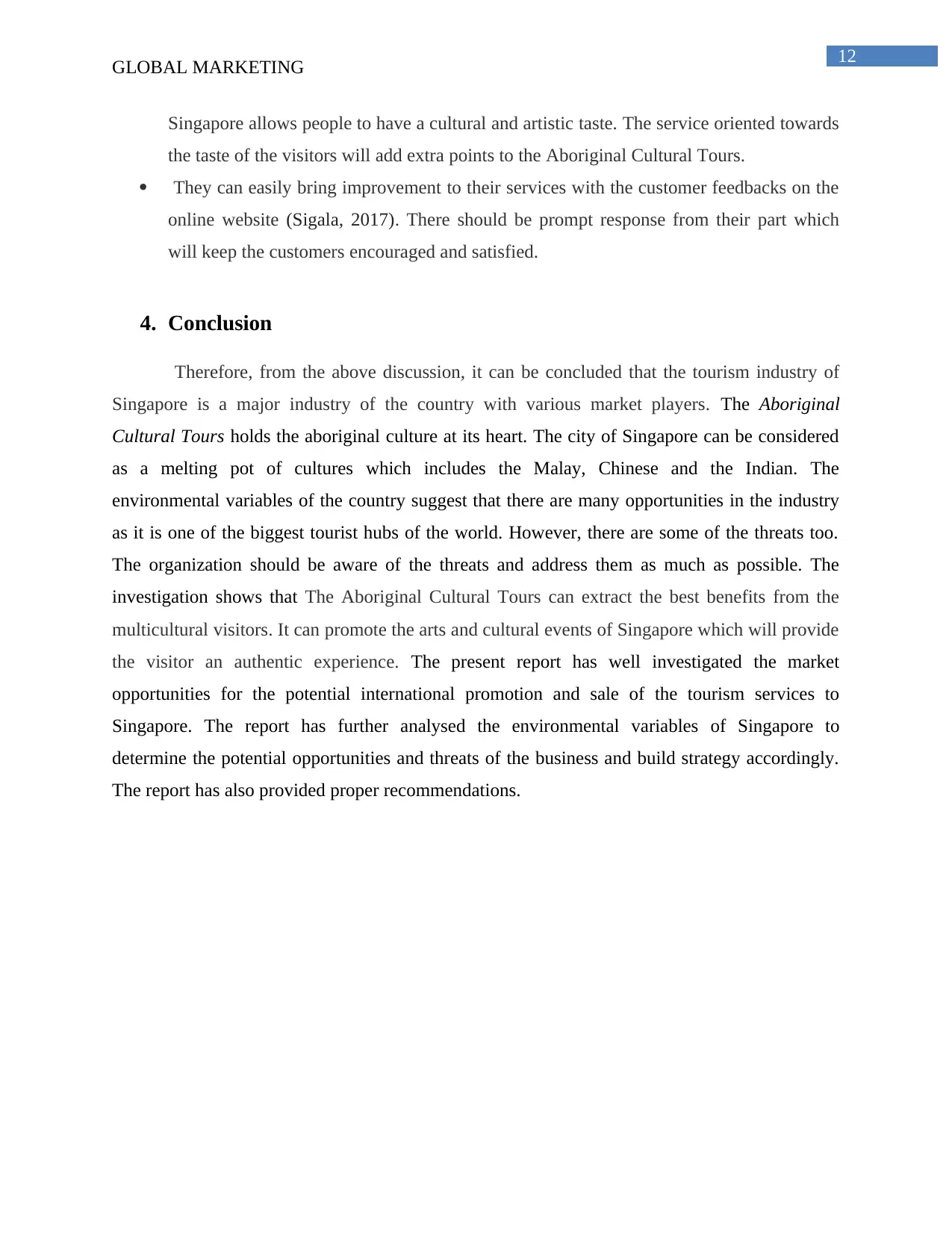
12
GLOBAL MARKETING
Singapore allows people to have a cultural and artistic taste. The service oriented towards
the taste of the visitors will add extra points to the Aboriginal Cultural Tours.
They can easily bring improvement to their services with the customer feedbacks on the
online website (Sigala, 2017). There should be prompt response from their part which
will keep the customers encouraged and satisfied.
4. Conclusion
Therefore, from the above discussion, it can be concluded that the tourism industry of
Singapore is a major industry of the country with various market players. The Aboriginal
Cultural Tours holds the aboriginal culture at its heart. The city of Singapore can be considered
as a melting pot of cultures which includes the Malay, Chinese and the Indian. The
environmental variables of the country suggest that there are many opportunities in the industry
as it is one of the biggest tourist hubs of the world. However, there are some of the threats too.
The organization should be aware of the threats and address them as much as possible. The
investigation shows that The Aboriginal Cultural Tours can extract the best benefits from the
multicultural visitors. It can promote the arts and cultural events of Singapore which will provide
the visitor an authentic experience. The present report has well investigated the market
opportunities for the potential international promotion and sale of the tourism services to
Singapore. The report has further analysed the environmental variables of Singapore to
determine the potential opportunities and threats of the business and build strategy accordingly.
The report has also provided proper recommendations.
GLOBAL MARKETING
Singapore allows people to have a cultural and artistic taste. The service oriented towards
the taste of the visitors will add extra points to the Aboriginal Cultural Tours.
They can easily bring improvement to their services with the customer feedbacks on the
online website (Sigala, 2017). There should be prompt response from their part which
will keep the customers encouraged and satisfied.
4. Conclusion
Therefore, from the above discussion, it can be concluded that the tourism industry of
Singapore is a major industry of the country with various market players. The Aboriginal
Cultural Tours holds the aboriginal culture at its heart. The city of Singapore can be considered
as a melting pot of cultures which includes the Malay, Chinese and the Indian. The
environmental variables of the country suggest that there are many opportunities in the industry
as it is one of the biggest tourist hubs of the world. However, there are some of the threats too.
The organization should be aware of the threats and address them as much as possible. The
investigation shows that The Aboriginal Cultural Tours can extract the best benefits from the
multicultural visitors. It can promote the arts and cultural events of Singapore which will provide
the visitor an authentic experience. The present report has well investigated the market
opportunities for the potential international promotion and sale of the tourism services to
Singapore. The report has further analysed the environmental variables of Singapore to
determine the potential opportunities and threats of the business and build strategy accordingly.
The report has also provided proper recommendations.
Paraphrase This Document
Need a fresh take? Get an instant paraphrase of this document with our AI Paraphraser
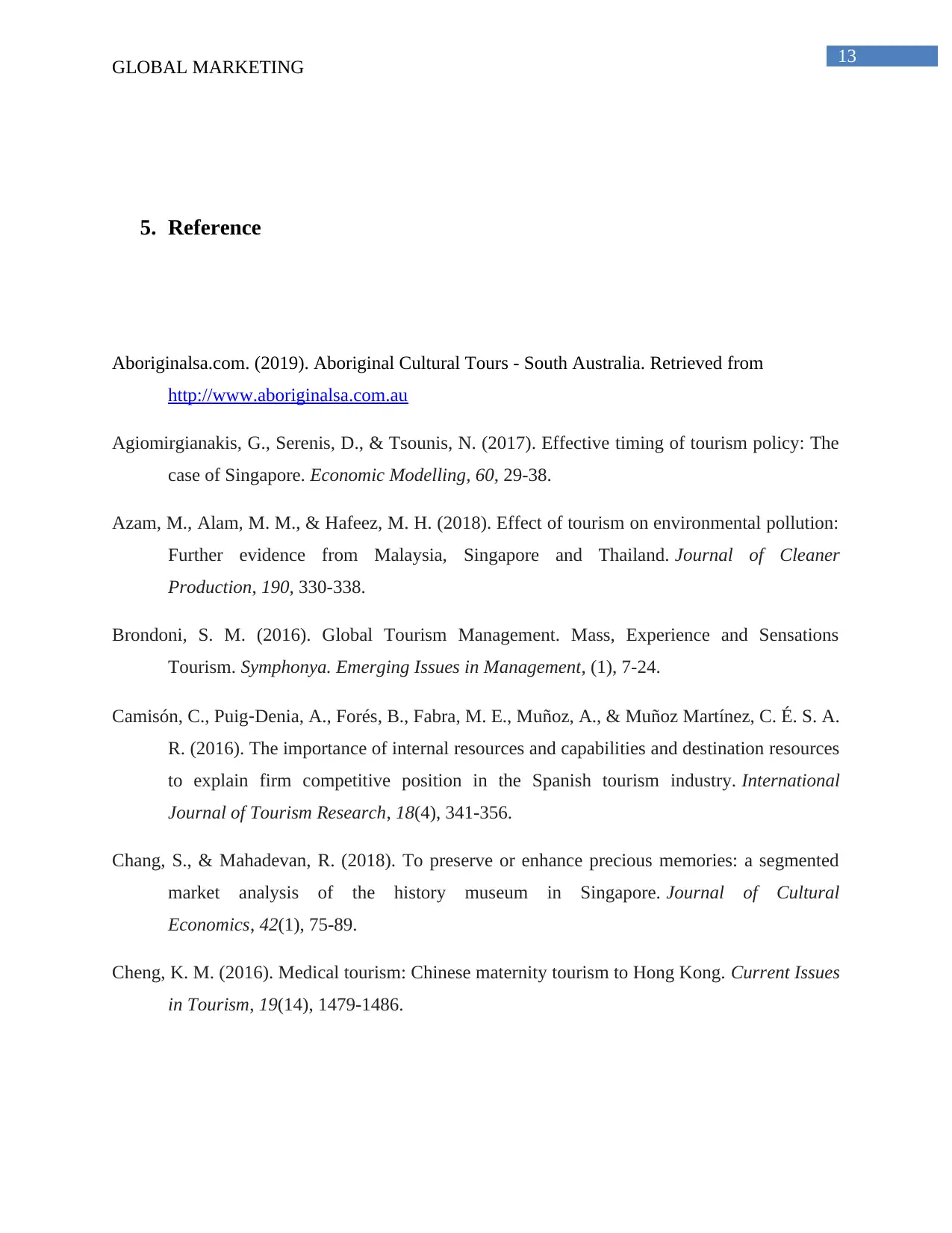
13
GLOBAL MARKETING
5. Reference
Aboriginalsa.com. (2019). Aboriginal Cultural Tours - South Australia. Retrieved from
http://www.aboriginalsa.com.au
Agiomirgianakis, G., Serenis, D., & Tsounis, N. (2017). Effective timing of tourism policy: The
case of Singapore. Economic Modelling, 60, 29-38.
Azam, M., Alam, M. M., & Hafeez, M. H. (2018). Effect of tourism on environmental pollution:
Further evidence from Malaysia, Singapore and Thailand. Journal of Cleaner
Production, 190, 330-338.
Brondoni, S. M. (2016). Global Tourism Management. Mass, Experience and Sensations
Tourism. Symphonya. Emerging Issues in Management, (1), 7-24.
Camisón, C., Puig‐Denia, A., Forés, B., Fabra, M. E., Muñoz, A., & Muñoz Martínez, C. É. S. A.
R. (2016). The importance of internal resources and capabilities and destination resources
to explain firm competitive position in the Spanish tourism industry. International
Journal of Tourism Research, 18(4), 341-356.
Chang, S., & Mahadevan, R. (2018). To preserve or enhance precious memories: a segmented
market analysis of the history museum in Singapore. Journal of Cultural
Economics, 42(1), 75-89.
Cheng, K. M. (2016). Medical tourism: Chinese maternity tourism to Hong Kong. Current Issues
in Tourism, 19(14), 1479-1486.
GLOBAL MARKETING
5. Reference
Aboriginalsa.com. (2019). Aboriginal Cultural Tours - South Australia. Retrieved from
http://www.aboriginalsa.com.au
Agiomirgianakis, G., Serenis, D., & Tsounis, N. (2017). Effective timing of tourism policy: The
case of Singapore. Economic Modelling, 60, 29-38.
Azam, M., Alam, M. M., & Hafeez, M. H. (2018). Effect of tourism on environmental pollution:
Further evidence from Malaysia, Singapore and Thailand. Journal of Cleaner
Production, 190, 330-338.
Brondoni, S. M. (2016). Global Tourism Management. Mass, Experience and Sensations
Tourism. Symphonya. Emerging Issues in Management, (1), 7-24.
Camisón, C., Puig‐Denia, A., Forés, B., Fabra, M. E., Muñoz, A., & Muñoz Martínez, C. É. S. A.
R. (2016). The importance of internal resources and capabilities and destination resources
to explain firm competitive position in the Spanish tourism industry. International
Journal of Tourism Research, 18(4), 341-356.
Chang, S., & Mahadevan, R. (2018). To preserve or enhance precious memories: a segmented
market analysis of the history museum in Singapore. Journal of Cultural
Economics, 42(1), 75-89.
Cheng, K. M. (2016). Medical tourism: Chinese maternity tourism to Hong Kong. Current Issues
in Tourism, 19(14), 1479-1486.
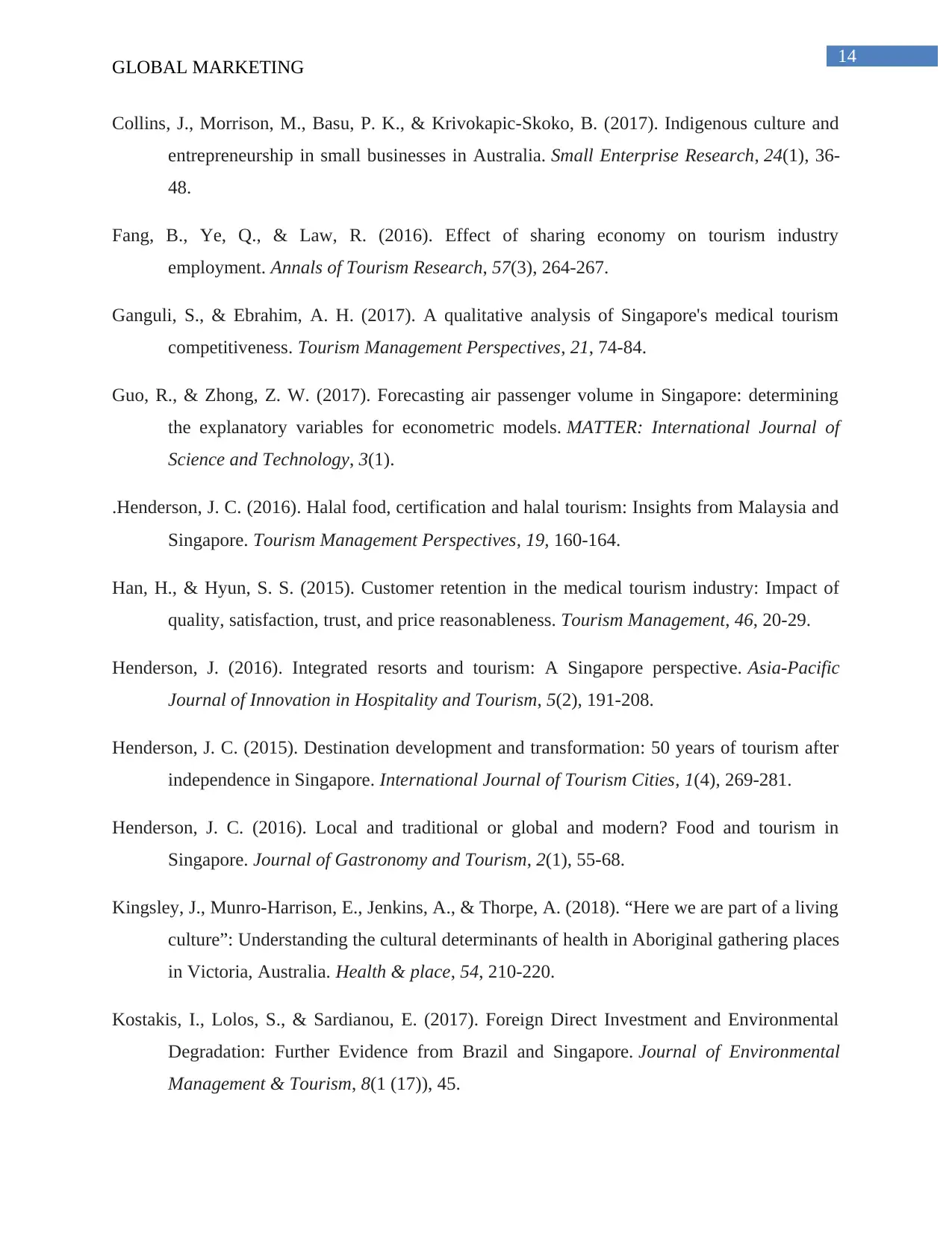
14
GLOBAL MARKETING
Collins, J., Morrison, M., Basu, P. K., & Krivokapic-Skoko, B. (2017). Indigenous culture and
entrepreneurship in small businesses in Australia. Small Enterprise Research, 24(1), 36-
48.
Fang, B., Ye, Q., & Law, R. (2016). Effect of sharing economy on tourism industry
employment. Annals of Tourism Research, 57(3), 264-267.
Ganguli, S., & Ebrahim, A. H. (2017). A qualitative analysis of Singapore's medical tourism
competitiveness. Tourism Management Perspectives, 21, 74-84.
Guo, R., & Zhong, Z. W. (2017). Forecasting air passenger volume in Singapore: determining
the explanatory variables for econometric models. MATTER: International Journal of
Science and Technology, 3(1).
.Henderson, J. C. (2016). Halal food, certification and halal tourism: Insights from Malaysia and
Singapore. Tourism Management Perspectives, 19, 160-164.
Han, H., & Hyun, S. S. (2015). Customer retention in the medical tourism industry: Impact of
quality, satisfaction, trust, and price reasonableness. Tourism Management, 46, 20-29.
Henderson, J. (2016). Integrated resorts and tourism: A Singapore perspective. Asia-Pacific
Journal of Innovation in Hospitality and Tourism, 5(2), 191-208.
Henderson, J. C. (2015). Destination development and transformation: 50 years of tourism after
independence in Singapore. International Journal of Tourism Cities, 1(4), 269-281.
Henderson, J. C. (2016). Local and traditional or global and modern? Food and tourism in
Singapore. Journal of Gastronomy and Tourism, 2(1), 55-68.
Kingsley, J., Munro-Harrison, E., Jenkins, A., & Thorpe, A. (2018). “Here we are part of a living
culture”: Understanding the cultural determinants of health in Aboriginal gathering places
in Victoria, Australia. Health & place, 54, 210-220.
Kostakis, I., Lolos, S., & Sardianou, E. (2017). Foreign Direct Investment and Environmental
Degradation: Further Evidence from Brazil and Singapore. Journal of Environmental
Management & Tourism, 8(1 (17)), 45.
GLOBAL MARKETING
Collins, J., Morrison, M., Basu, P. K., & Krivokapic-Skoko, B. (2017). Indigenous culture and
entrepreneurship in small businesses in Australia. Small Enterprise Research, 24(1), 36-
48.
Fang, B., Ye, Q., & Law, R. (2016). Effect of sharing economy on tourism industry
employment. Annals of Tourism Research, 57(3), 264-267.
Ganguli, S., & Ebrahim, A. H. (2017). A qualitative analysis of Singapore's medical tourism
competitiveness. Tourism Management Perspectives, 21, 74-84.
Guo, R., & Zhong, Z. W. (2017). Forecasting air passenger volume in Singapore: determining
the explanatory variables for econometric models. MATTER: International Journal of
Science and Technology, 3(1).
.Henderson, J. C. (2016). Halal food, certification and halal tourism: Insights from Malaysia and
Singapore. Tourism Management Perspectives, 19, 160-164.
Han, H., & Hyun, S. S. (2015). Customer retention in the medical tourism industry: Impact of
quality, satisfaction, trust, and price reasonableness. Tourism Management, 46, 20-29.
Henderson, J. (2016). Integrated resorts and tourism: A Singapore perspective. Asia-Pacific
Journal of Innovation in Hospitality and Tourism, 5(2), 191-208.
Henderson, J. C. (2015). Destination development and transformation: 50 years of tourism after
independence in Singapore. International Journal of Tourism Cities, 1(4), 269-281.
Henderson, J. C. (2016). Local and traditional or global and modern? Food and tourism in
Singapore. Journal of Gastronomy and Tourism, 2(1), 55-68.
Kingsley, J., Munro-Harrison, E., Jenkins, A., & Thorpe, A. (2018). “Here we are part of a living
culture”: Understanding the cultural determinants of health in Aboriginal gathering places
in Victoria, Australia. Health & place, 54, 210-220.
Kostakis, I., Lolos, S., & Sardianou, E. (2017). Foreign Direct Investment and Environmental
Degradation: Further Evidence from Brazil and Singapore. Journal of Environmental
Management & Tourism, 8(1 (17)), 45.
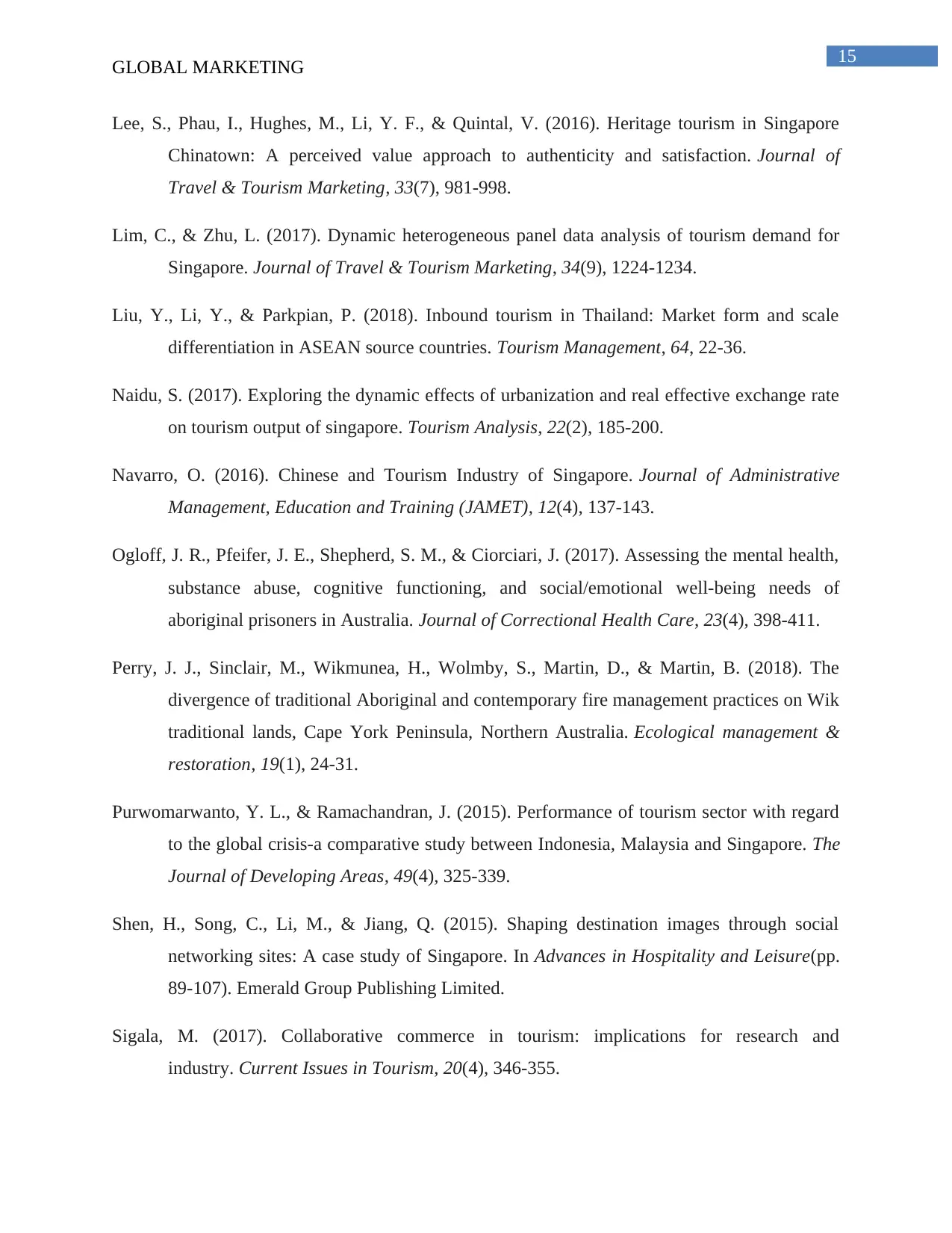
15
GLOBAL MARKETING
Lee, S., Phau, I., Hughes, M., Li, Y. F., & Quintal, V. (2016). Heritage tourism in Singapore
Chinatown: A perceived value approach to authenticity and satisfaction. Journal of
Travel & Tourism Marketing, 33(7), 981-998.
Lim, C., & Zhu, L. (2017). Dynamic heterogeneous panel data analysis of tourism demand for
Singapore. Journal of Travel & Tourism Marketing, 34(9), 1224-1234.
Liu, Y., Li, Y., & Parkpian, P. (2018). Inbound tourism in Thailand: Market form and scale
differentiation in ASEAN source countries. Tourism Management, 64, 22-36.
Naidu, S. (2017). Exploring the dynamic effects of urbanization and real effective exchange rate
on tourism output of singapore. Tourism Analysis, 22(2), 185-200.
Navarro, O. (2016). Chinese and Tourism Industry of Singapore. Journal of Administrative
Management, Education and Training (JAMET), 12(4), 137-143.
Ogloff, J. R., Pfeifer, J. E., Shepherd, S. M., & Ciorciari, J. (2017). Assessing the mental health,
substance abuse, cognitive functioning, and social/emotional well-being needs of
aboriginal prisoners in Australia. Journal of Correctional Health Care, 23(4), 398-411.
Perry, J. J., Sinclair, M., Wikmunea, H., Wolmby, S., Martin, D., & Martin, B. (2018). The
divergence of traditional Aboriginal and contemporary fire management practices on Wik
traditional lands, Cape York Peninsula, Northern Australia. Ecological management &
restoration, 19(1), 24-31.
Purwomarwanto, Y. L., & Ramachandran, J. (2015). Performance of tourism sector with regard
to the global crisis-a comparative study between Indonesia, Malaysia and Singapore. The
Journal of Developing Areas, 49(4), 325-339.
Shen, H., Song, C., Li, M., & Jiang, Q. (2015). Shaping destination images through social
networking sites: A case study of Singapore. In Advances in Hospitality and Leisure(pp.
89-107). Emerald Group Publishing Limited.
Sigala, M. (2017). Collaborative commerce in tourism: implications for research and
industry. Current Issues in Tourism, 20(4), 346-355.
GLOBAL MARKETING
Lee, S., Phau, I., Hughes, M., Li, Y. F., & Quintal, V. (2016). Heritage tourism in Singapore
Chinatown: A perceived value approach to authenticity and satisfaction. Journal of
Travel & Tourism Marketing, 33(7), 981-998.
Lim, C., & Zhu, L. (2017). Dynamic heterogeneous panel data analysis of tourism demand for
Singapore. Journal of Travel & Tourism Marketing, 34(9), 1224-1234.
Liu, Y., Li, Y., & Parkpian, P. (2018). Inbound tourism in Thailand: Market form and scale
differentiation in ASEAN source countries. Tourism Management, 64, 22-36.
Naidu, S. (2017). Exploring the dynamic effects of urbanization and real effective exchange rate
on tourism output of singapore. Tourism Analysis, 22(2), 185-200.
Navarro, O. (2016). Chinese and Tourism Industry of Singapore. Journal of Administrative
Management, Education and Training (JAMET), 12(4), 137-143.
Ogloff, J. R., Pfeifer, J. E., Shepherd, S. M., & Ciorciari, J. (2017). Assessing the mental health,
substance abuse, cognitive functioning, and social/emotional well-being needs of
aboriginal prisoners in Australia. Journal of Correctional Health Care, 23(4), 398-411.
Perry, J. J., Sinclair, M., Wikmunea, H., Wolmby, S., Martin, D., & Martin, B. (2018). The
divergence of traditional Aboriginal and contemporary fire management practices on Wik
traditional lands, Cape York Peninsula, Northern Australia. Ecological management &
restoration, 19(1), 24-31.
Purwomarwanto, Y. L., & Ramachandran, J. (2015). Performance of tourism sector with regard
to the global crisis-a comparative study between Indonesia, Malaysia and Singapore. The
Journal of Developing Areas, 49(4), 325-339.
Shen, H., Song, C., Li, M., & Jiang, Q. (2015). Shaping destination images through social
networking sites: A case study of Singapore. In Advances in Hospitality and Leisure(pp.
89-107). Emerald Group Publishing Limited.
Sigala, M. (2017). Collaborative commerce in tourism: implications for research and
industry. Current Issues in Tourism, 20(4), 346-355.
Secure Best Marks with AI Grader
Need help grading? Try our AI Grader for instant feedback on your assignments.
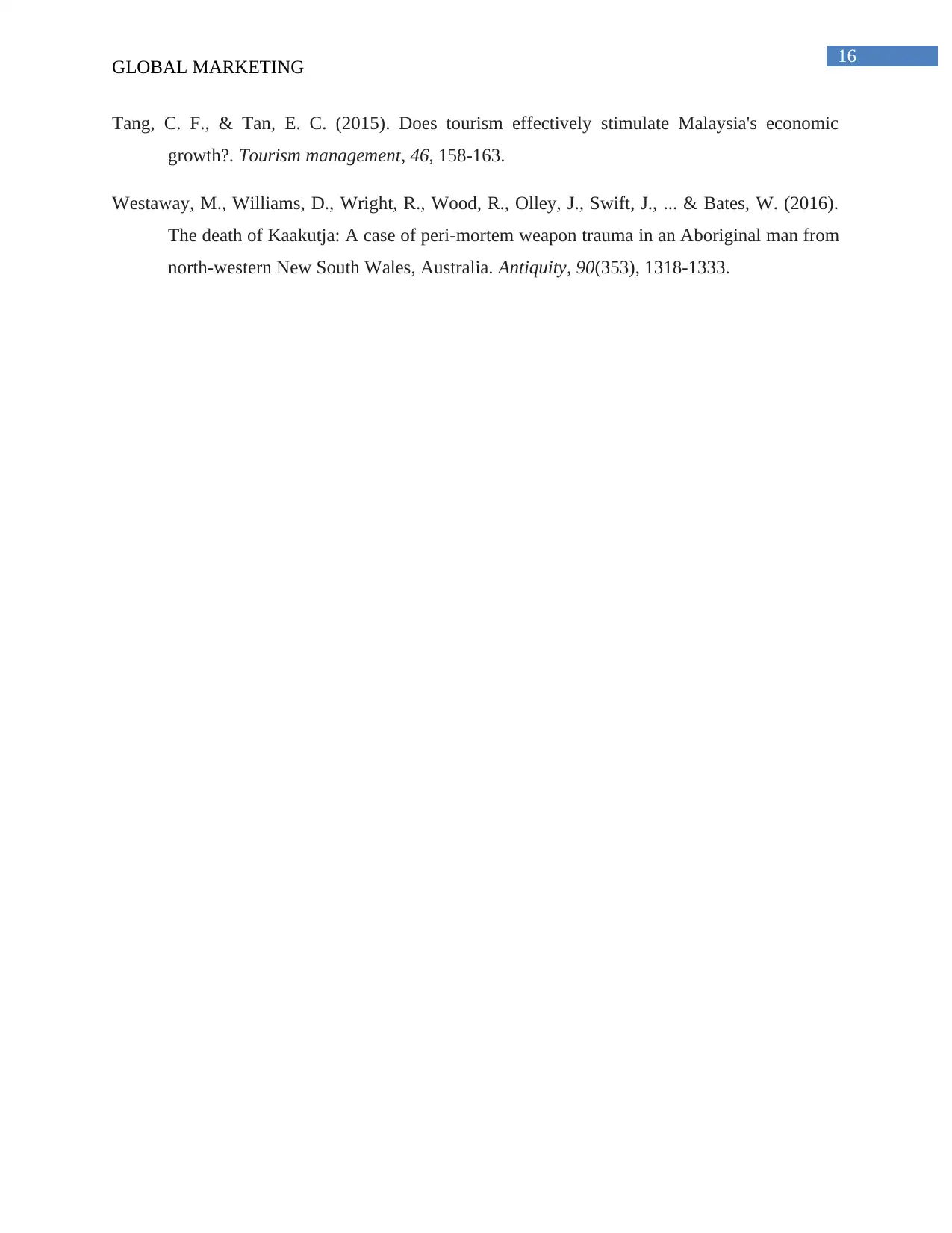
16
GLOBAL MARKETING
Tang, C. F., & Tan, E. C. (2015). Does tourism effectively stimulate Malaysia's economic
growth?. Tourism management, 46, 158-163.
Westaway, M., Williams, D., Wright, R., Wood, R., Olley, J., Swift, J., ... & Bates, W. (2016).
The death of Kaakutja: A case of peri-mortem weapon trauma in an Aboriginal man from
north-western New South Wales, Australia. Antiquity, 90(353), 1318-1333.
GLOBAL MARKETING
Tang, C. F., & Tan, E. C. (2015). Does tourism effectively stimulate Malaysia's economic
growth?. Tourism management, 46, 158-163.
Westaway, M., Williams, D., Wright, R., Wood, R., Olley, J., Swift, J., ... & Bates, W. (2016).
The death of Kaakutja: A case of peri-mortem weapon trauma in an Aboriginal man from
north-western New South Wales, Australia. Antiquity, 90(353), 1318-1333.
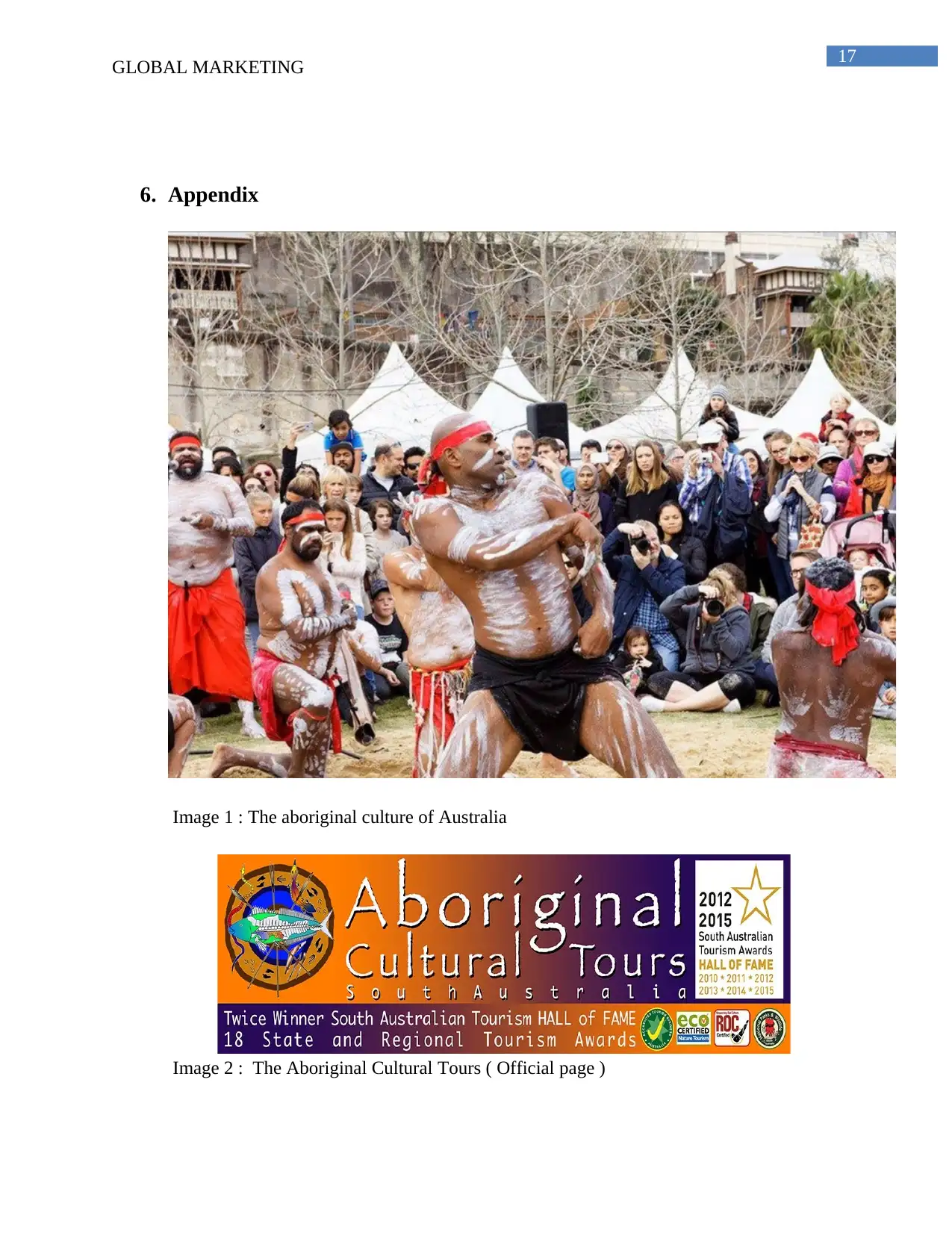
17
GLOBAL MARKETING
6. Appendix
Image 1 : The aboriginal culture of Australia
Image 2 : The Aboriginal Cultural Tours ( Official page )
GLOBAL MARKETING
6. Appendix
Image 1 : The aboriginal culture of Australia
Image 2 : The Aboriginal Cultural Tours ( Official page )
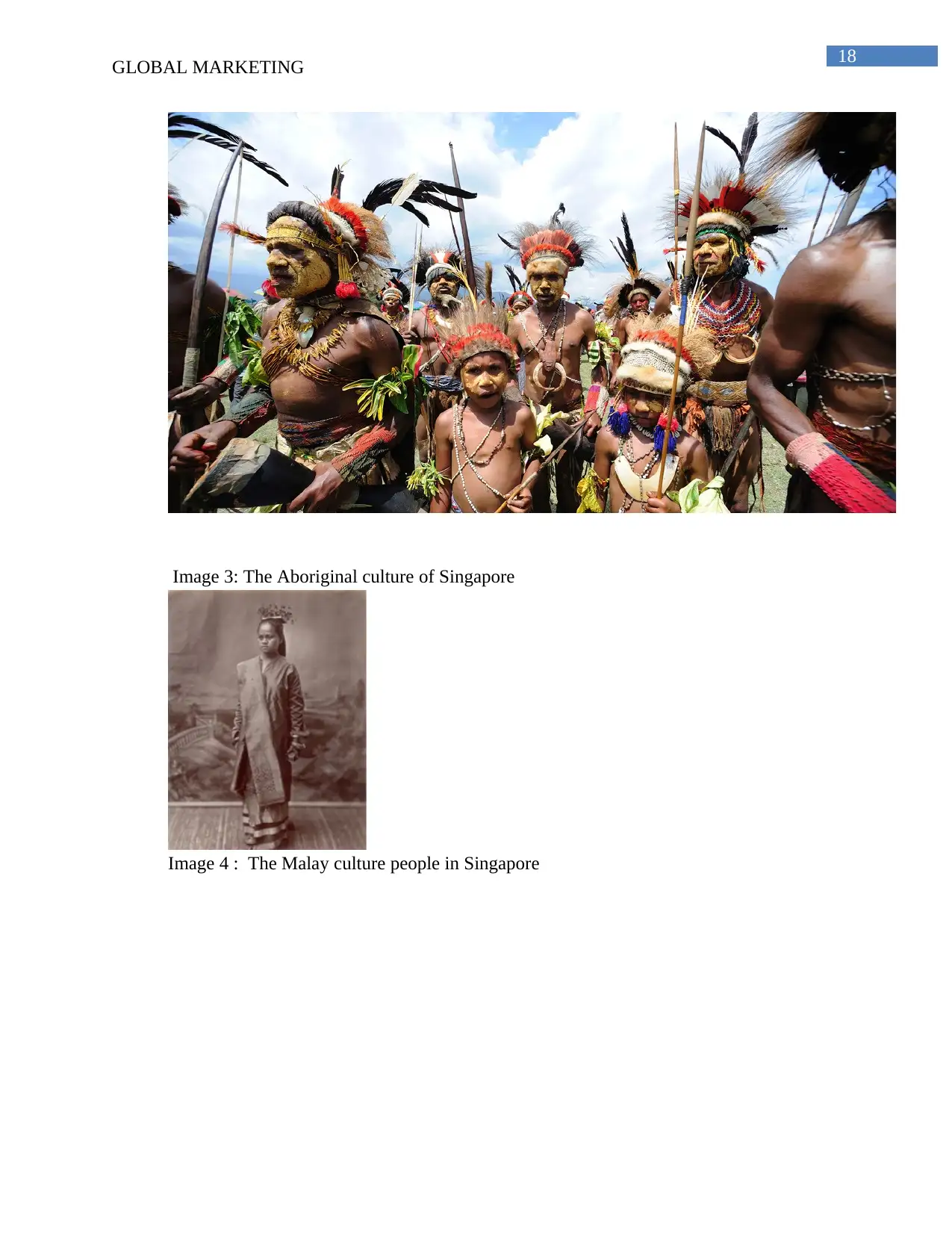
18
GLOBAL MARKETING
Image 3: The Aboriginal culture of Singapore
Image 4 : The Malay culture people in Singapore
GLOBAL MARKETING
Image 3: The Aboriginal culture of Singapore
Image 4 : The Malay culture people in Singapore
Paraphrase This Document
Need a fresh take? Get an instant paraphrase of this document with our AI Paraphraser
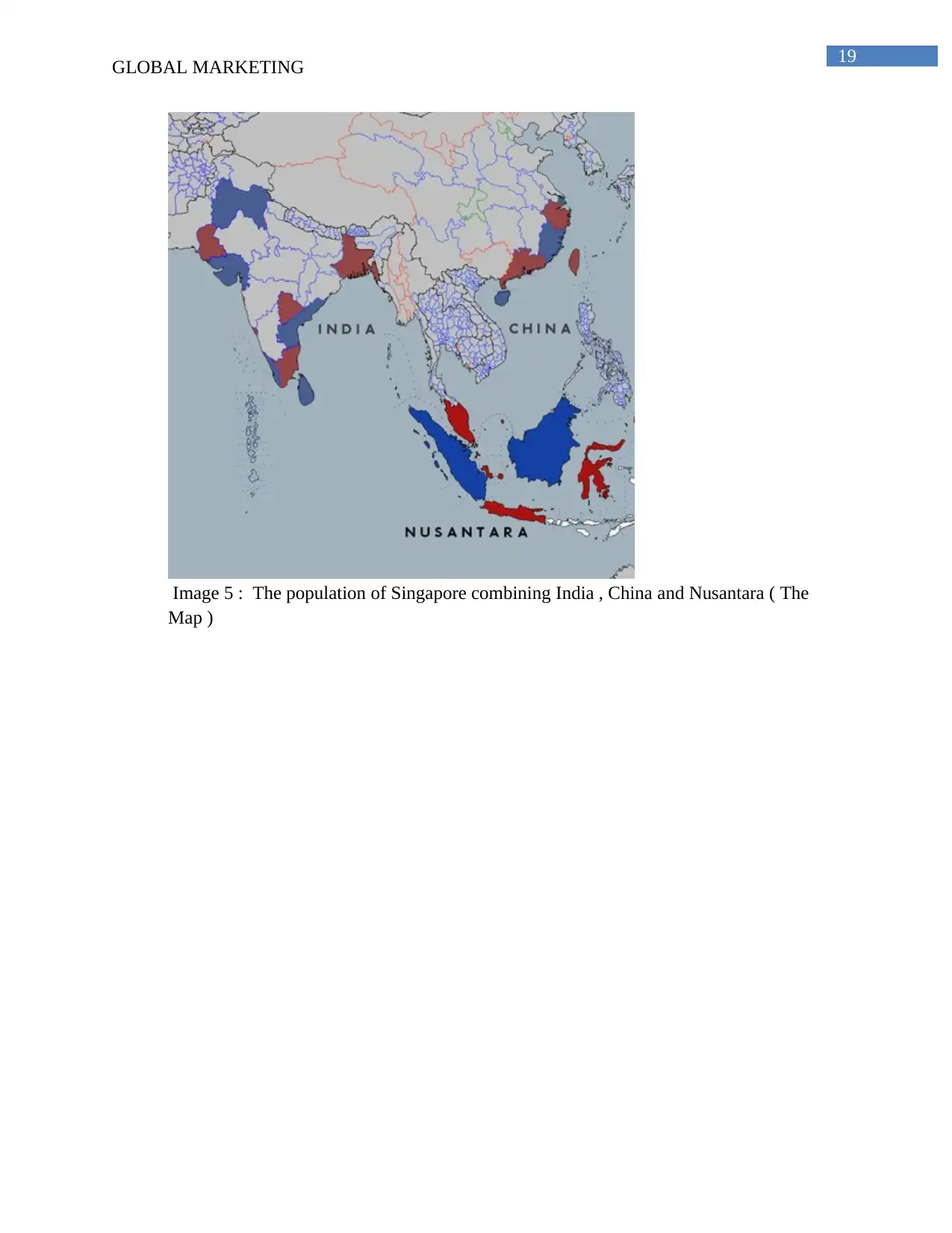
19
GLOBAL MARKETING
Image 5 : The population of Singapore combining India , China and Nusantara ( The
Map )
GLOBAL MARKETING
Image 5 : The population of Singapore combining India , China and Nusantara ( The
Map )
1 out of 20
Related Documents
Your All-in-One AI-Powered Toolkit for Academic Success.
+13062052269
info@desklib.com
Available 24*7 on WhatsApp / Email
![[object Object]](/_next/static/media/star-bottom.7253800d.svg)
Unlock your academic potential
© 2024 | Zucol Services PVT LTD | All rights reserved.





